Introduction
KWELI JOURNAL, in partnership with the SCHOMBURG CENTER FOR RESEARCH IN BLACK CULTURE, presented THE EYES HAVE IT: POETRY AND PHOTOGRAPHY with NIKKY FINNEY, RACHEL ELIZA GRIFFITHS and PARNESHIA JONES on Thursday, April 23, 2015. SARETTA MORGAN moderated the conversation. Please see Vimeo links to the poetry reading (Part 1) and conversation (Part II). The transcript below has been edited and abridged for publication.
Love was palpable in the Schomburg Center that April evening as we gathered in the atrium under the Black Life Matters banner. But Freddie Gray's recent death was also on the minds and hearts of many. Nikky Finney, who rarely shares the beginnings of things that she wants to write, made an exception that night. A phrase had been running through her head while she was on the plane to us from South Carolina: If only we had body cameras, this would stop. "And I’ve been working on a poem about the Hubble Telescope because I’m fascinated with it and how it changed how we look at the planets and the solar system. It just changed everything. And I said, ‘Oh my gosh. We need a Hubble Telescope. We don’t need body cameras. Black people need to make a Hubble Telescope and set it in the head, the arms, the eyes of every person who calls himself or herself a policeman. Because this violence, this murder, this killing is perpetuated on and on because people don’t tell the truth. And a young man’s 25 year old body, his spine does not get broken 80% out of the camera’s eye. And we’re going to debate this for years in the way that we debate all the others. And you’re right, Rachel. This will continue so we need something else. That’s all I know right now. Hubble. Glass. Grandma’s truth telling jar."
America is essentially illiterate when it comes to black bodies.
SARETTA MORGAN: I’m really interested in the title of your lyric video, Silent Syntax. Particularly as a black woman, I feel that I am often torn between two really unsatisfactory choices: remaining silent, or articulating out of, and into, a very historical and regulatory expression of thought. I look at English with its syntax and its grammars and all of the other kind of constraints that comprise the legibility of a shared language. And I think that with poetry and images, especially together, there is the possibility of creating more space or maybe different kinds of space for language for us. So maybe we can talk a little about some of that.
I want to start off the conversation with the poem that is very explicitly evoked in your film: The Black Unicorn. It ends in the idea of freedom. I would like to take the last two lines of that poem and turn it over to each of you. How do you personally interpret those last two lines and what kind of freedom does it speak to for you and maybe where are there limitations? What do they preclude and what do they make possible for you, for your practice as writers and visual artists, as editors and as essayists, and as people in the world, as friends?
RACHEL ELIZA GRIFFITHS: Silent Syntax is a visual conversation in practice that keeps a poem like Lorde’s in the flesh, and keeps it moving, And my hope is that some of us will go away and open up her book and think about that Black Unicorn and just the idea of a unicorn in relationship to race and how and what that might mean. I began thinking about Audre Lorde’s poem, The Black Unicorn about two years ago and it kept shifting in its shape, restless and unrelenting. There was this idea of freedom, within a myth, and thinking of the very dangerous and brutal mythology that happens in this country. America, for me, is essentially illiterate when it comes to black bodies, and in particular the very intricate and complex ecosystem of black women and black women’s needs and desires and intuition and intelligence, in all kinds of ways. The grammar of black flesh is almost integral to the body that is America. And so trying to access and repel into that space meant language as well as a visual lexicon, a visual vocabulary because we absorb images and definitions of ourselves.
In my role as a photographer, I place my body both in front of the lens and behind the lens. For me, this is freedom and power and naming. Many of the photographs you see tonight are in conversation with other visual artists. The Two Elizas, the double self portrait, is in conversation with Frida Kahlo, but also with Lucille Clifton’s poem, Won’t You Come Celebrate With Me, which is my one hand holding tight my other hand. And so that is part of the way that image came up.
NIKKY FINNEY: When I was little, my mother called me her sensitive child, and it wasn’t a compliment. But I grew into the compliment by holding onto my sensitive child stuff. And I wrote an essay a couple of years ago called Hog Killing, just about that. When I would go to the farm and my grandfather was about to kill the hog for Thanksgiving. And the farmers would be coming down the road with the rope, the salt and all that stuff. I would see them before I could hear anything. And so, I have always trusted my eyes. With or without a camera, I trust my eyes. And I trusted my eyes even before I trusted my mouth or my words or my hand, my fingers, my pencils. And I still trust my eyes, which goes back to the Hubble Telescope. But I’m not going on that right now. I have so many students who don’t trust what they see. They don’t trust their eyes. And so photography for me was always a way of double trusting my eyes, to see the thing and then to take a picture of the thing, and then to have the thing long after I saw it.
I’ll never forget. I was really young. I was always listening in to old people’s conversations which I found fascinating and terrifying. And there was an old woman once talking on the porch, because the porch was the place, and she said ‘that slavery thing didn’t happen.’ She said ‘show me a picture. You show me a picture, then I’ll believe you.’ Of course, that sent me thinking about photography and when photography was born. I have students who don’t think slavery happened either because there are no photographs. They see photographs of the camps, the Jewish camps. They see the piles of bodies and they say, ‘Oh yeah, that happened. The other thing didn’t happen.’
Photography has always been really important to me as a human being. I take photographs. My first way of taking a photograph is with a pencil because it’s cheap and I don’t have to pay for film or a camera and I can put it behind my ear and I can be on the airplane and not worry that I have to cut it off. It’s always on. But the photograph, the photography thing is very sacred to me. I wrote a poem in the book before this one about when I had yellow jaundice as a baby and I had to stay in the hospital. Every time my mother recounts this story she starts crying because she had to leave me in the hospital for seven days. But I, in my imagination, not in my eye eye, but in my imagination eye, I remember being in the incubator. And there was a round opening that I remember like a lens out into the world. So the circle of the camera’s lens, the circle of the incubator, was how I targeted things like that nurse’s hand who came in and touched me every day to make sure I was okay. Magical realism? Am I remembering through magical realism? Giving myself permission? I don’t have actual memory of that, but I do have body memory. I think we have body memory and so I wanted to take a picture of that. So I snap the picture in my brain of that and I remember it and I recall it and I bring it forward into my life.
It’s the first time I’ve seen Rachel's film. And the first thing I thought of when I was looking at it was the silent movies that we were never in. Silent movies of us. I always see silent pictures of other people. And so I was fascinated that this brilliant poet and photographer is introducing us in 2015 to something that is supposed to only exist in the 1930s and that is what the imagination and the brain and the heart can make if you work really, really hard. So thank you.
PARNESHIA JONES: I’ve always been into photographs. I didn’t start writing until much much later. But photographs always seemed to help me ask questions about everything. My grandmother was a very big photographer. She always carried around two cameras. She always kept a camera in her car. She always kept a camera in the kitchen. She passed away about four years ago and as we were cleaning out her things, we literally had laundry baskets full of photographs. And she was very meticulous about everything, her cursive on the backs of each photograph. There is photograph of me, three and a half months. I mean, she was just so detailed.
Photographs help me write. It made me feel so at home to have Rachel’s photographs streaming in the background tonight. When I’m at home my television is on one channel: Turner Classic Movies. At night they have silent films. And so that has become like white noise for me. It plays in the background while I‘m cleaning, while I’m cooking, while I’m writing. And it’s something about those moving images, those still images that make me ask a lot of questions. These images also bring up a lot of contradictions. And seeing Rachel's film tonight brings something else to mind. As a black woman I was raised to follow all the rules. But it seems the decision makers don’t have to. ‘In God we trust. Every man created equal.’ What’s going on? I’m always asking questions because of the images, both the still images and the moving images. And these questions find their way into my poetry or prose, but also into my life as a publisher and an editor. I asked ‘where are all the black people in the Northwestern University Press list? Where are they?’ And my boss told me to answer it. And so I did with this lovely woman here and she answered it with the National Book Award.
I would like to plant some different kind of evidence about black women’s beauty and intelligence. Every one of these photographs is political, even though some of them are quite lyrical—including the ones of myself.
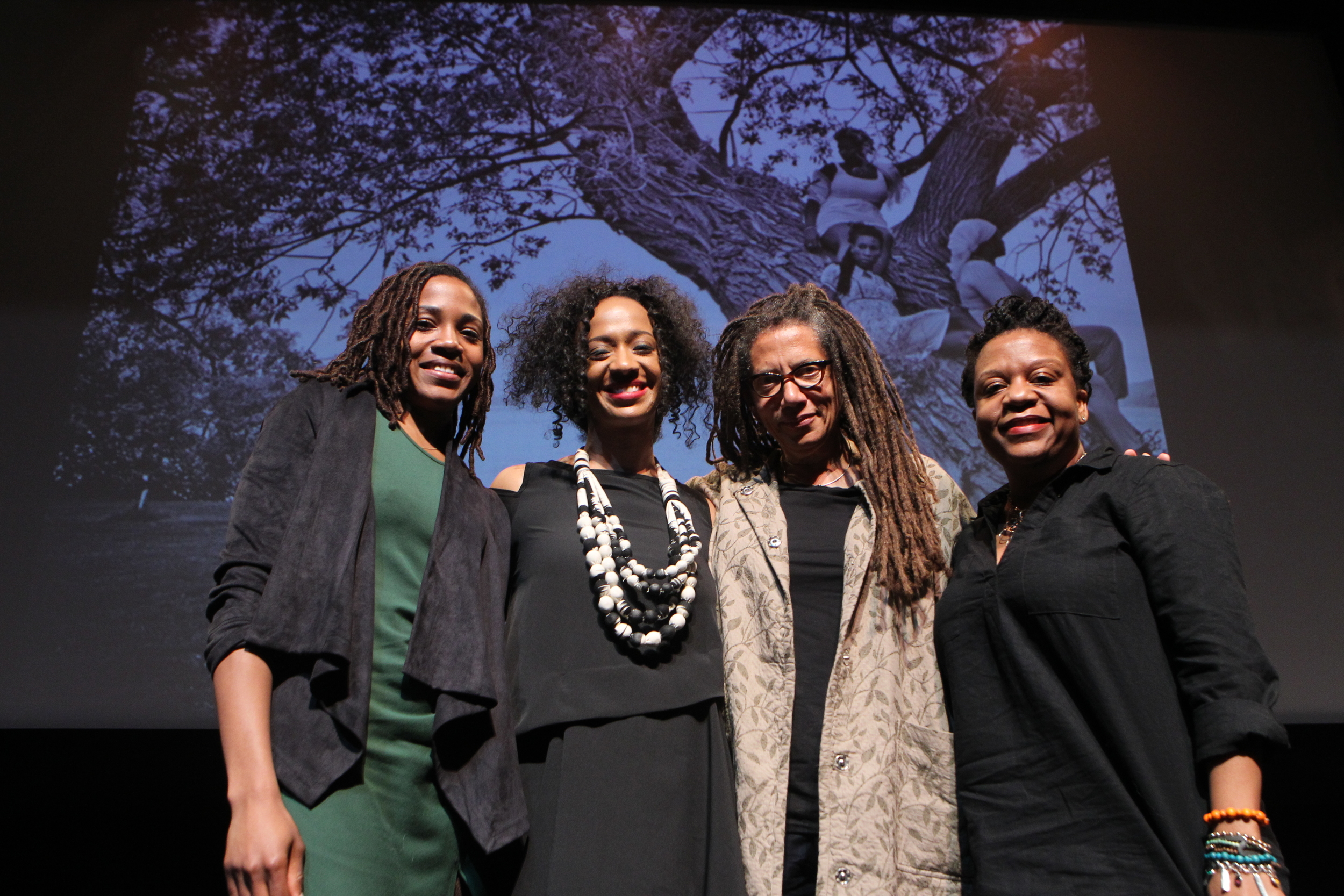
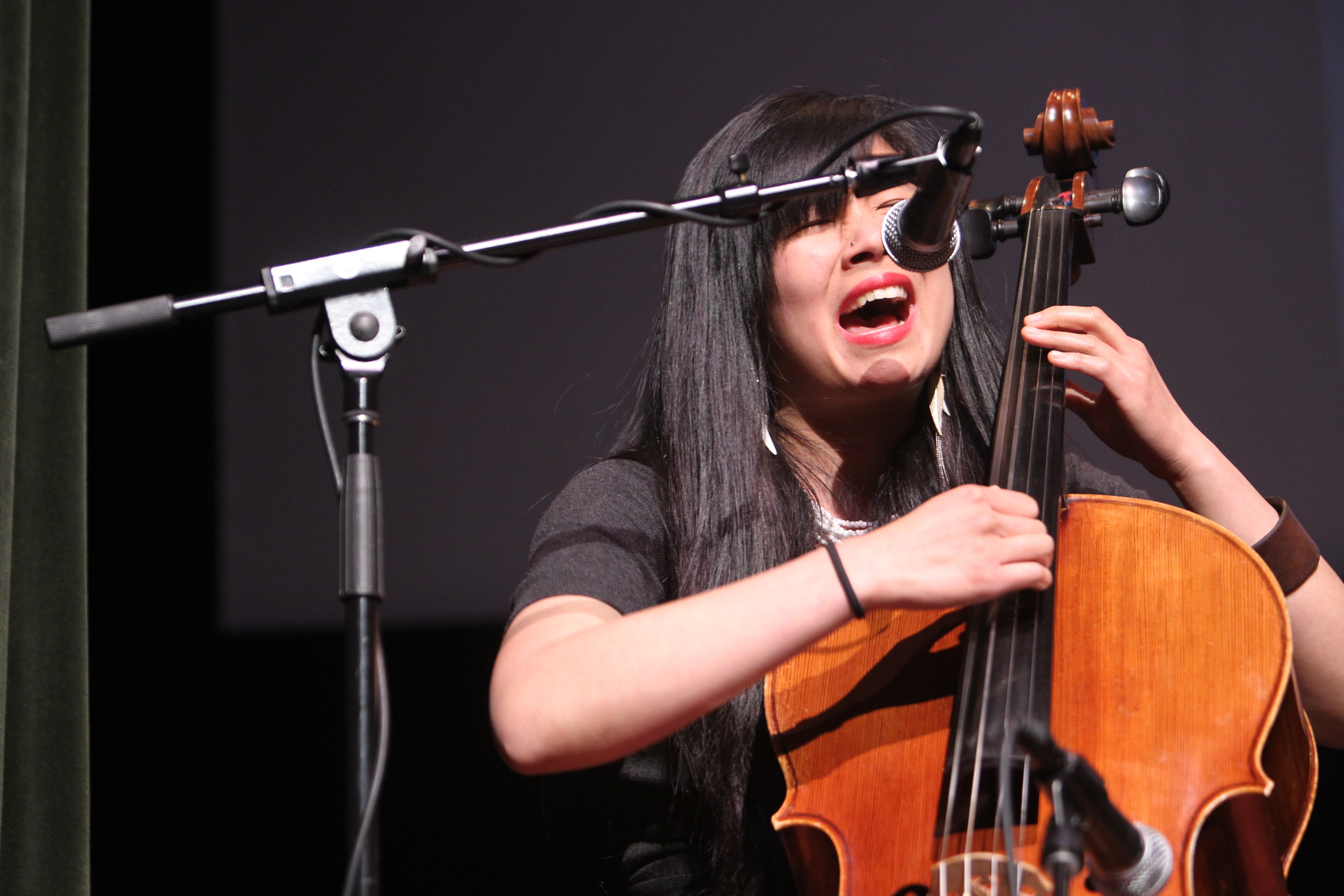
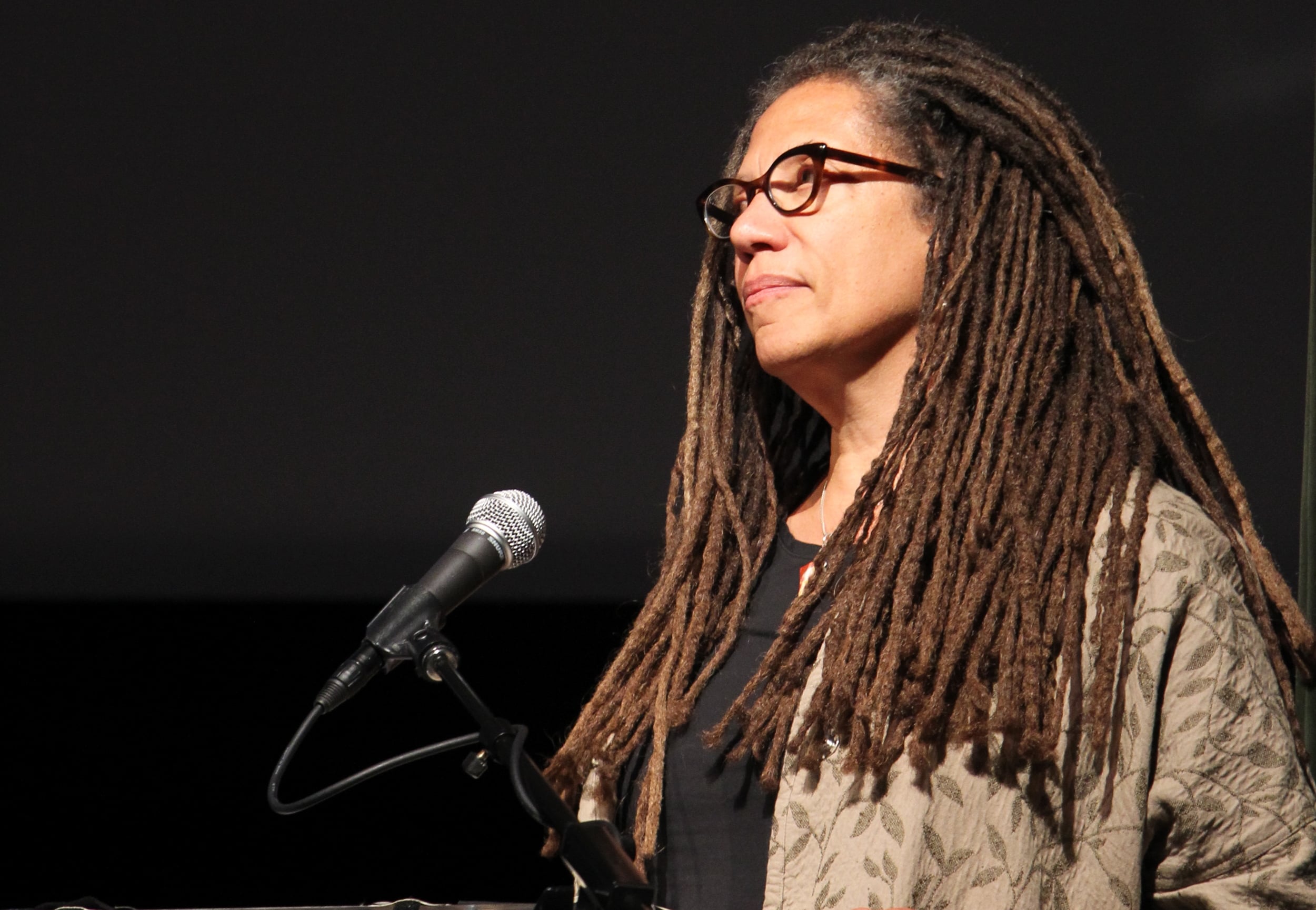
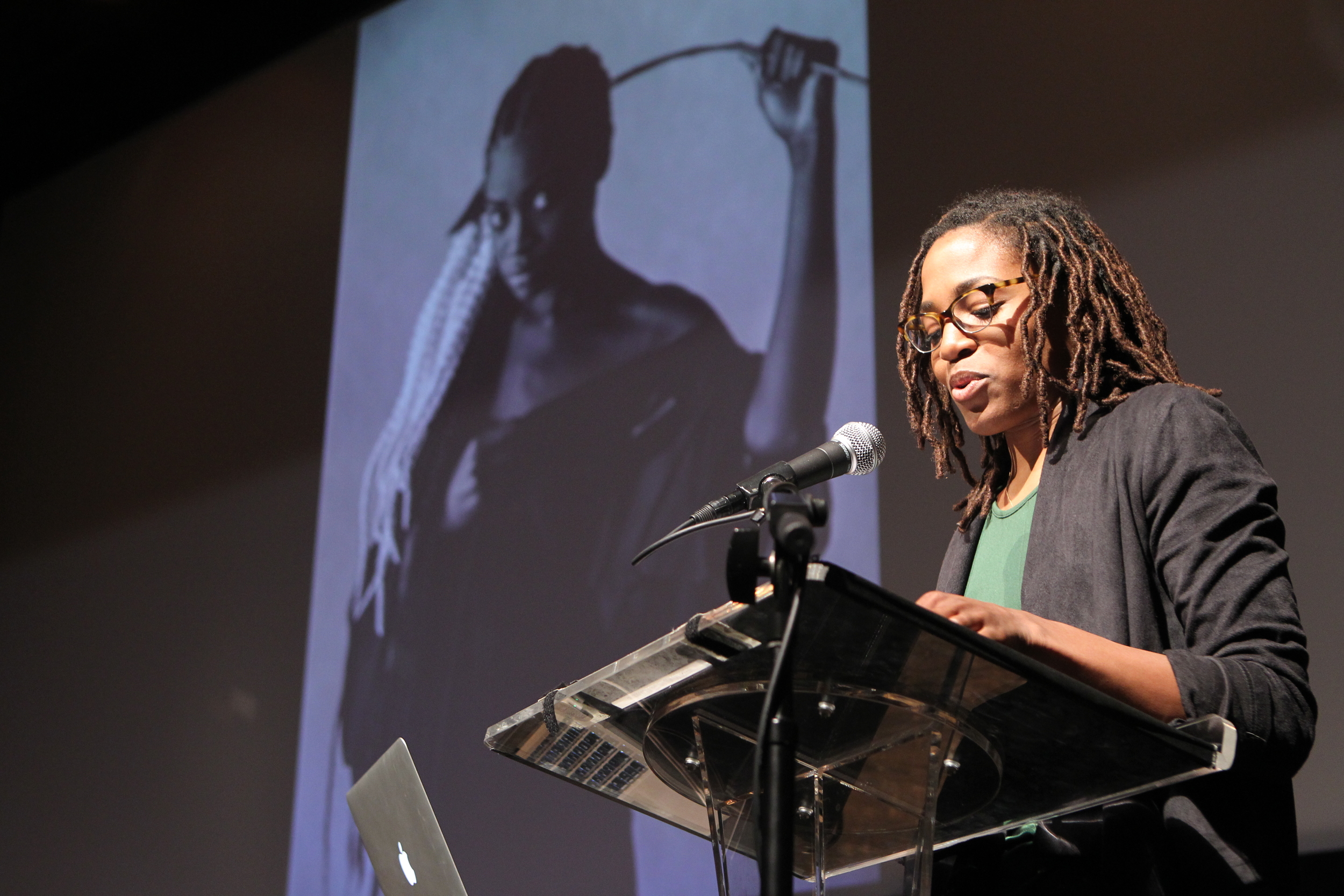
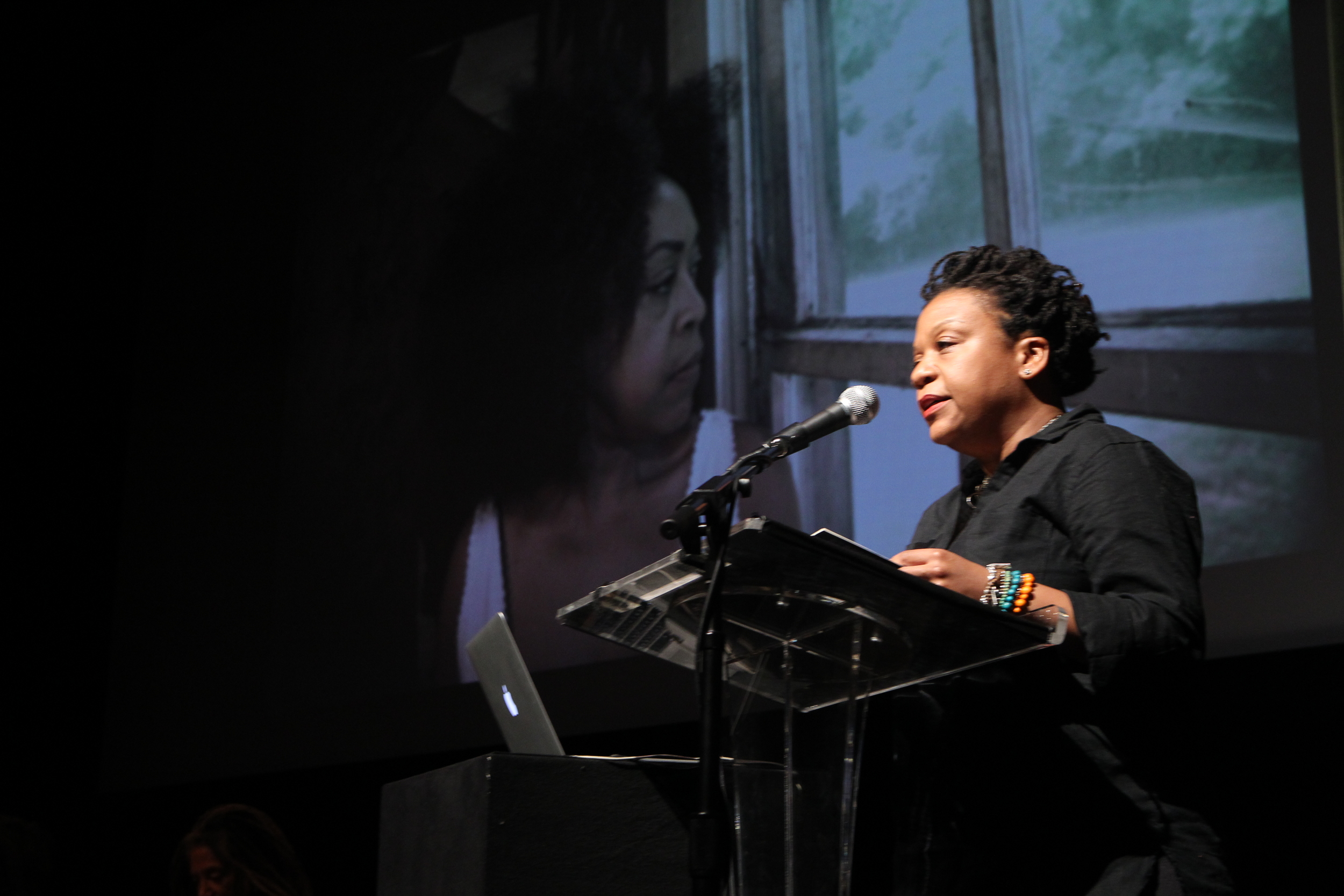



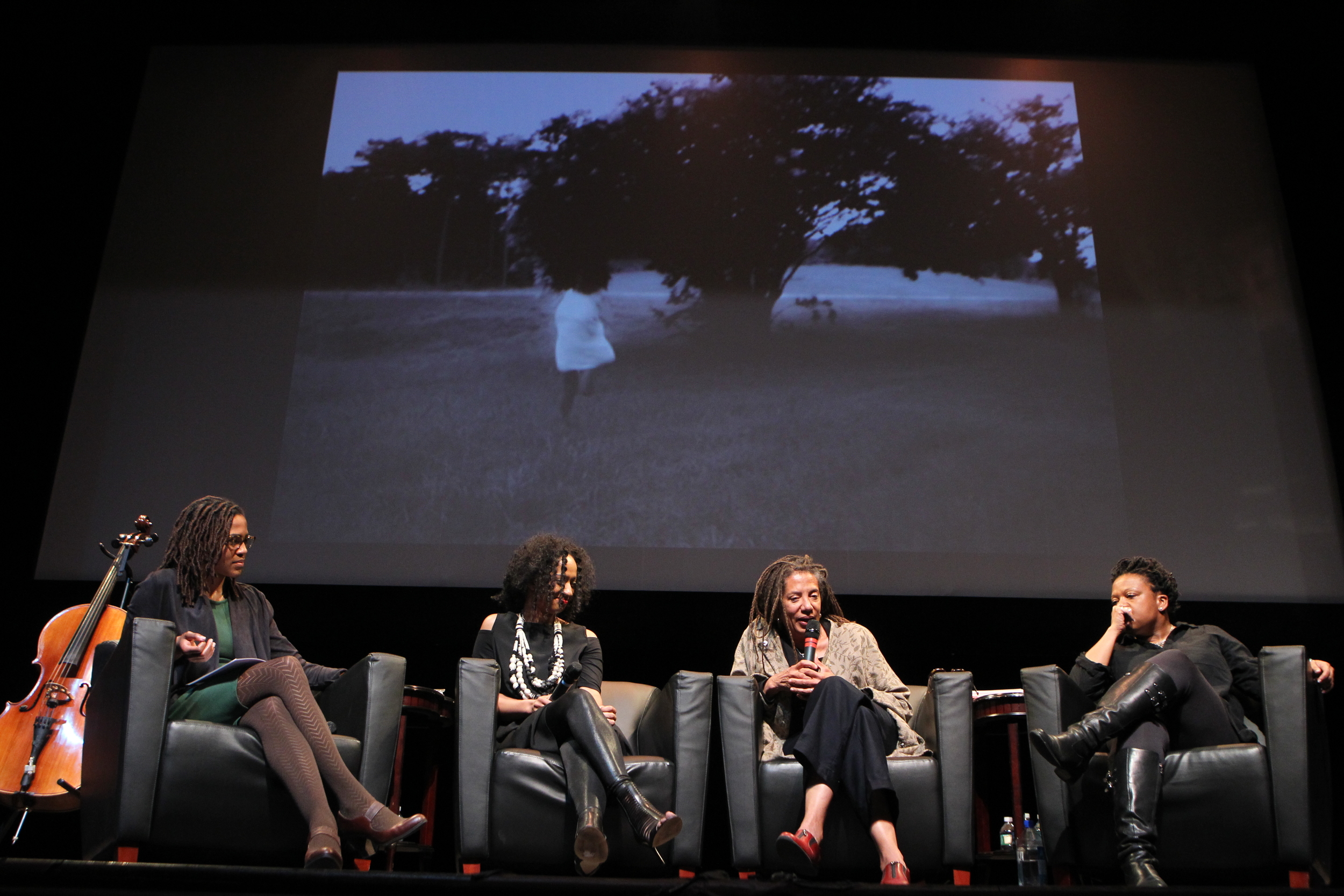
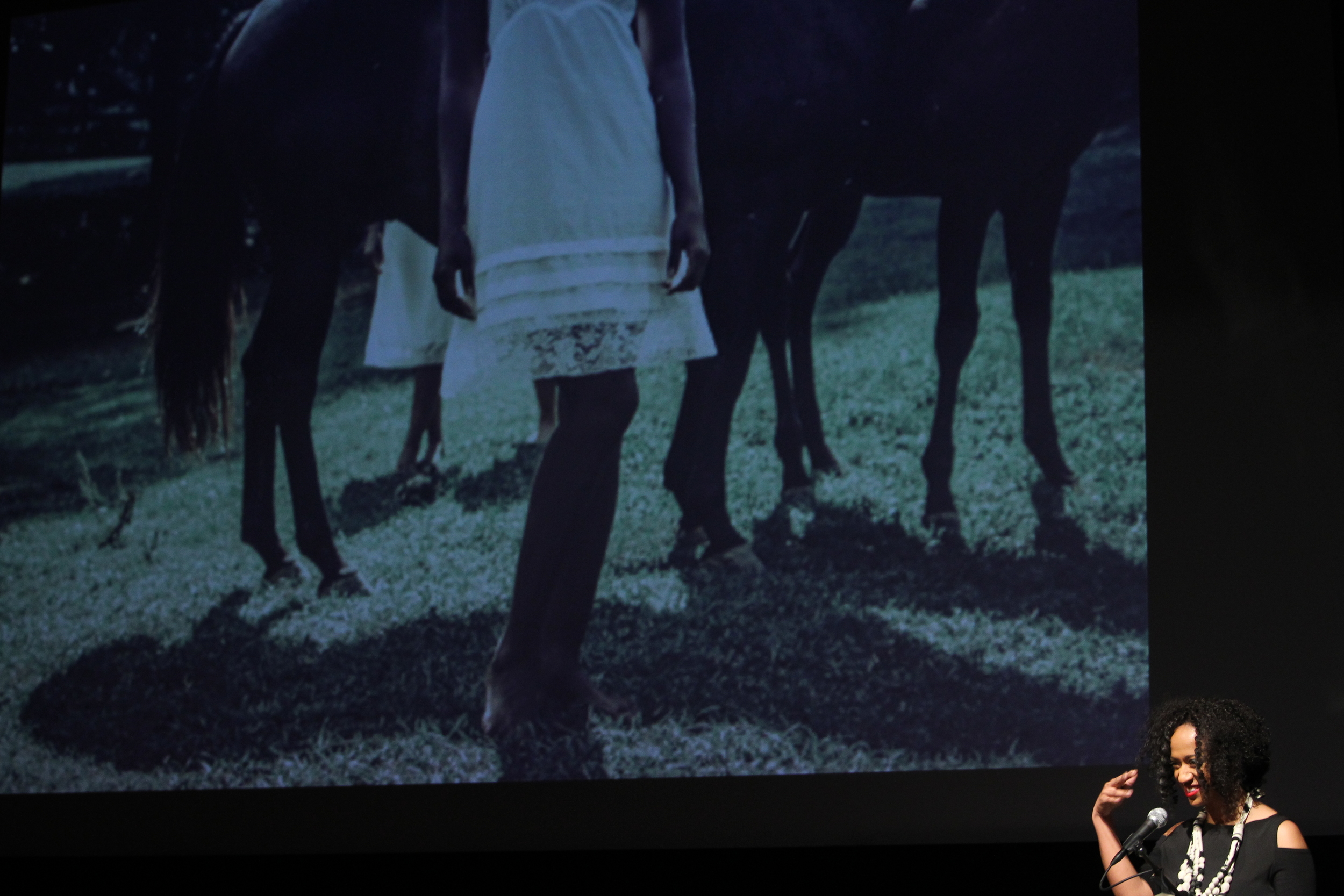
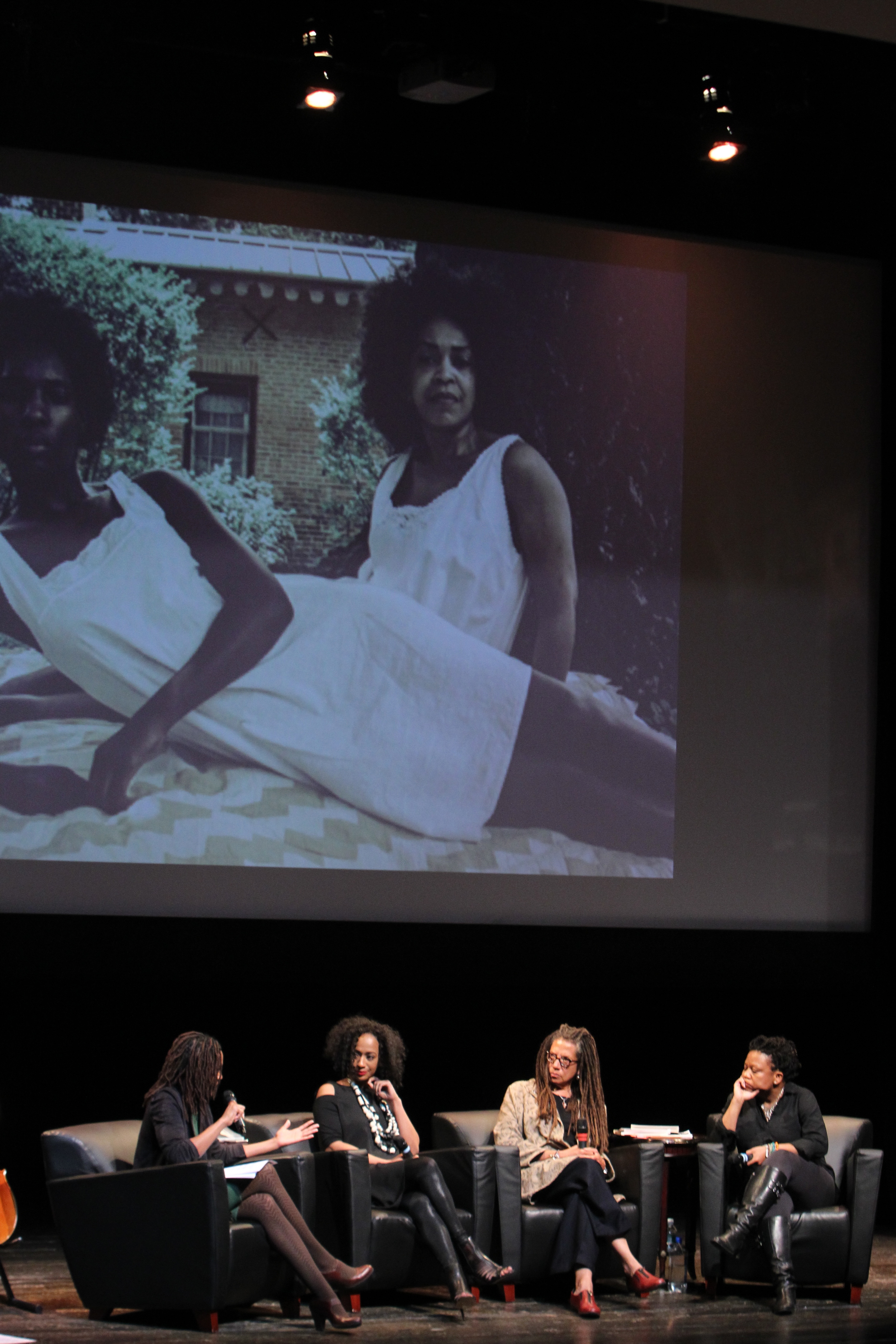
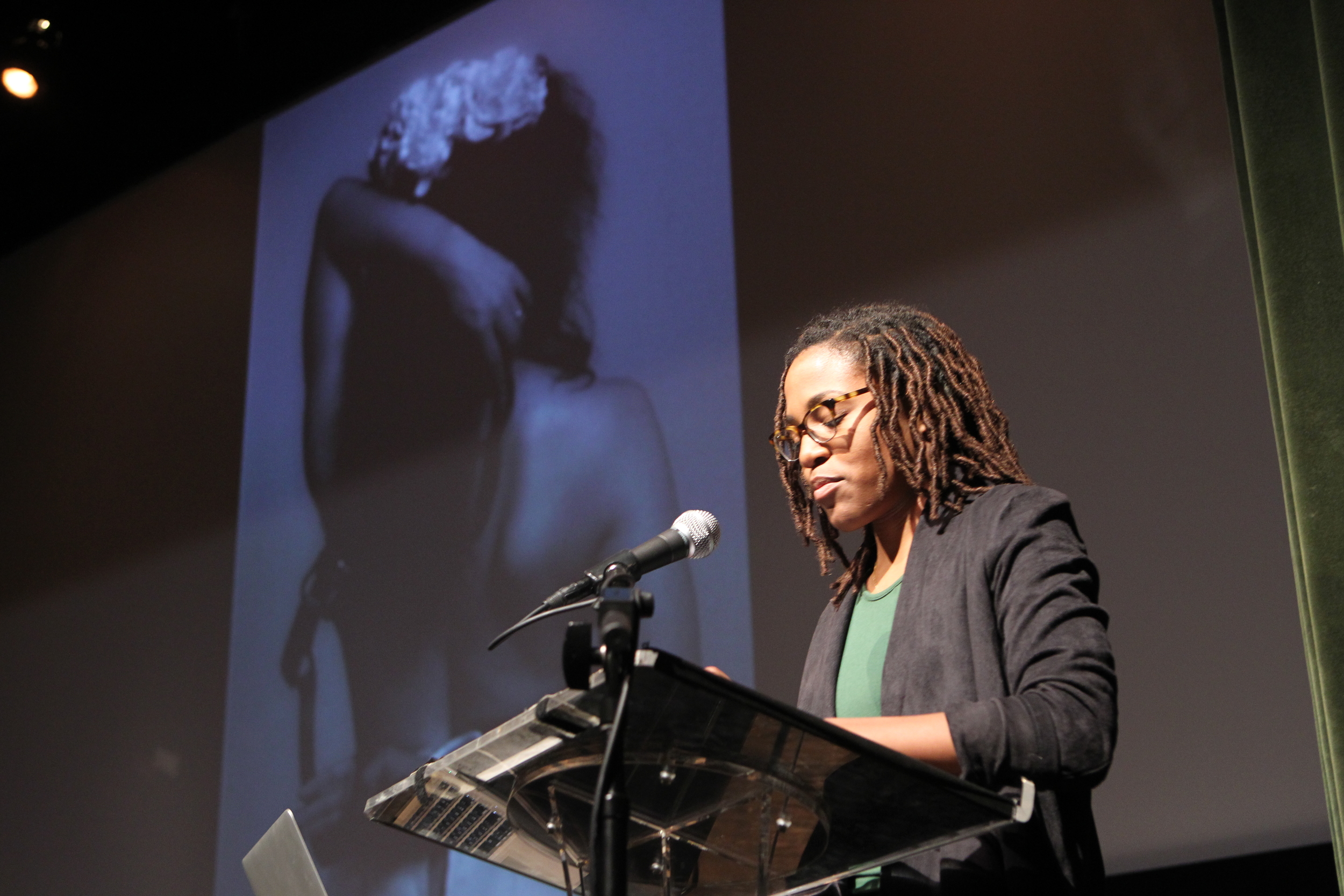
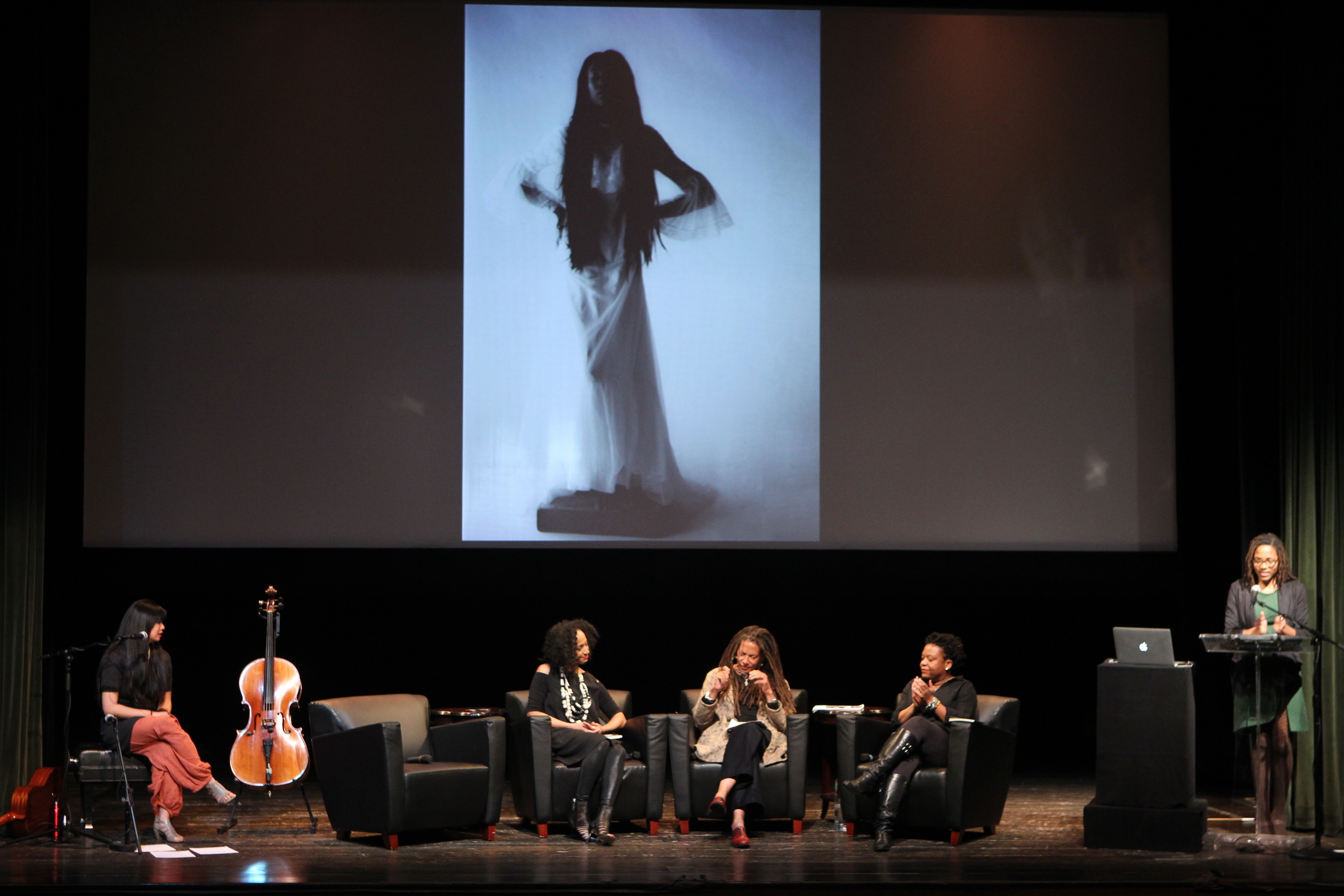
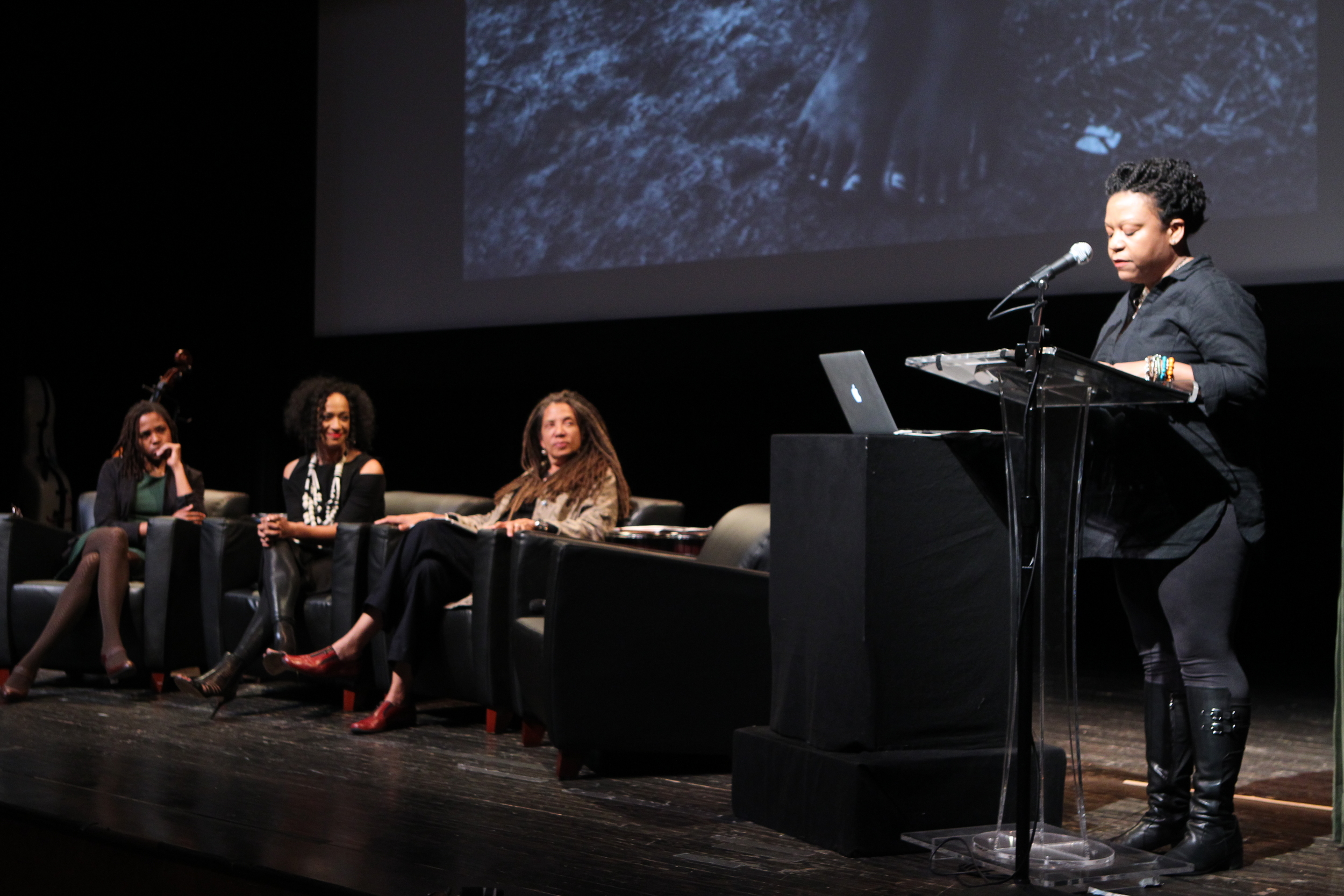
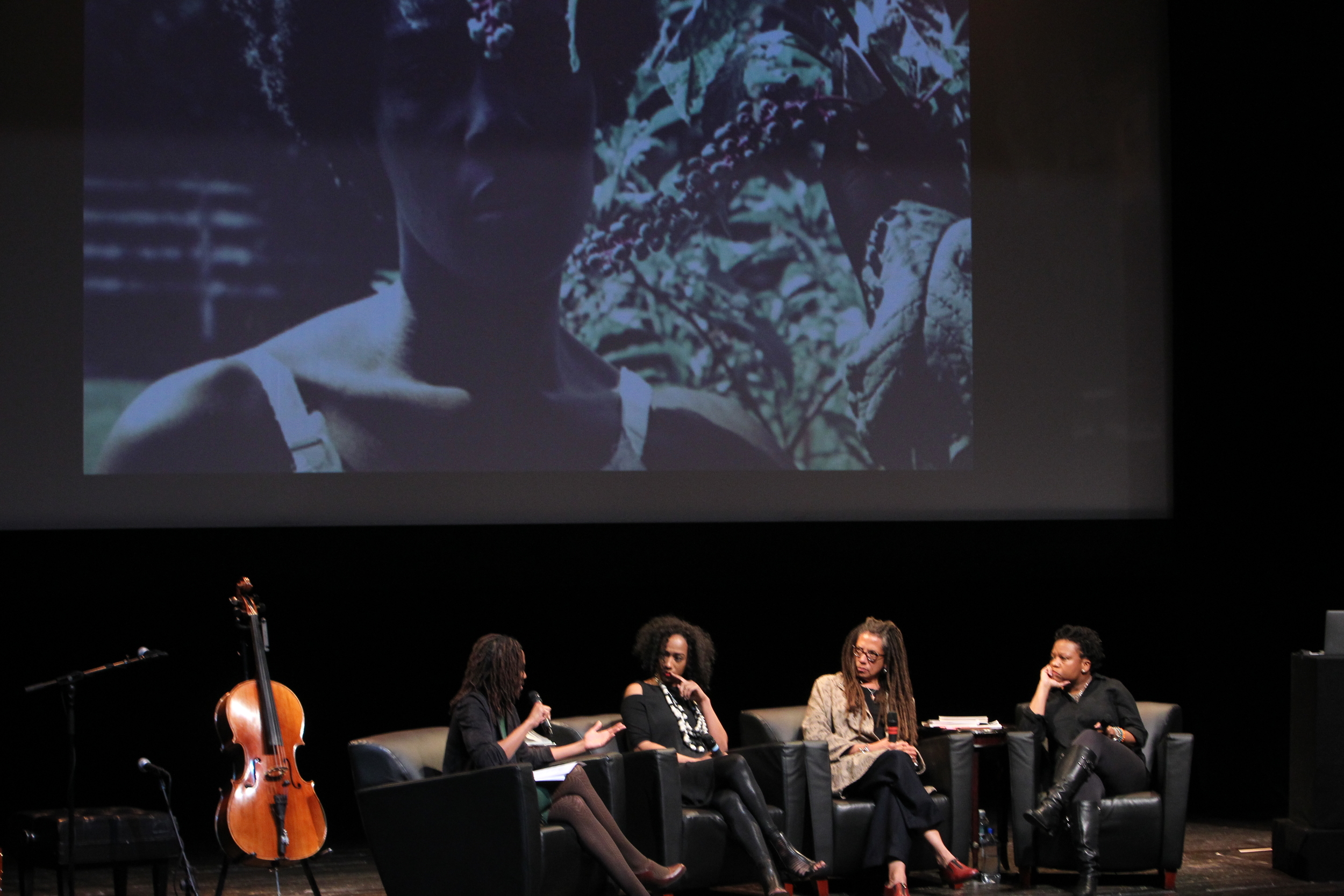
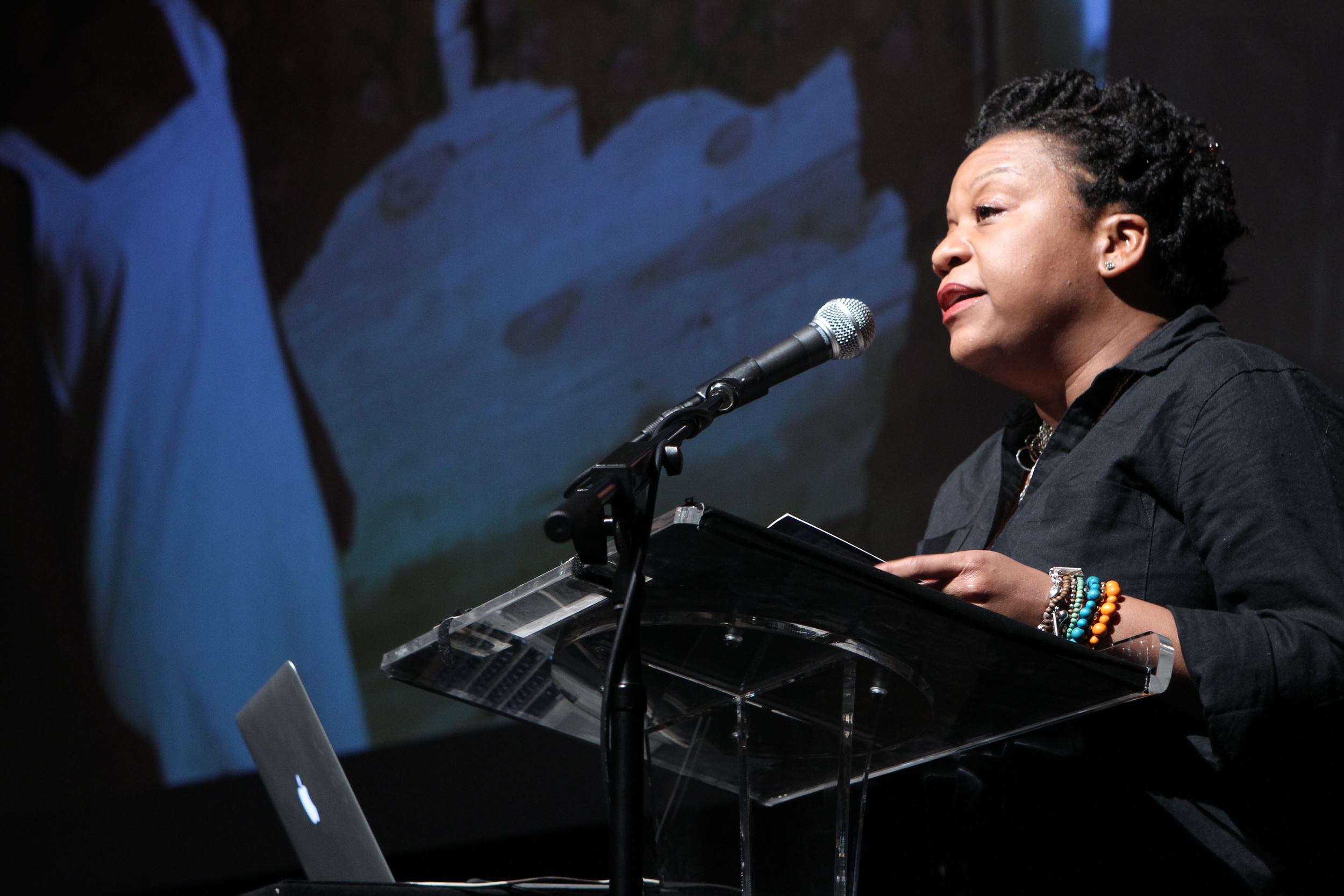
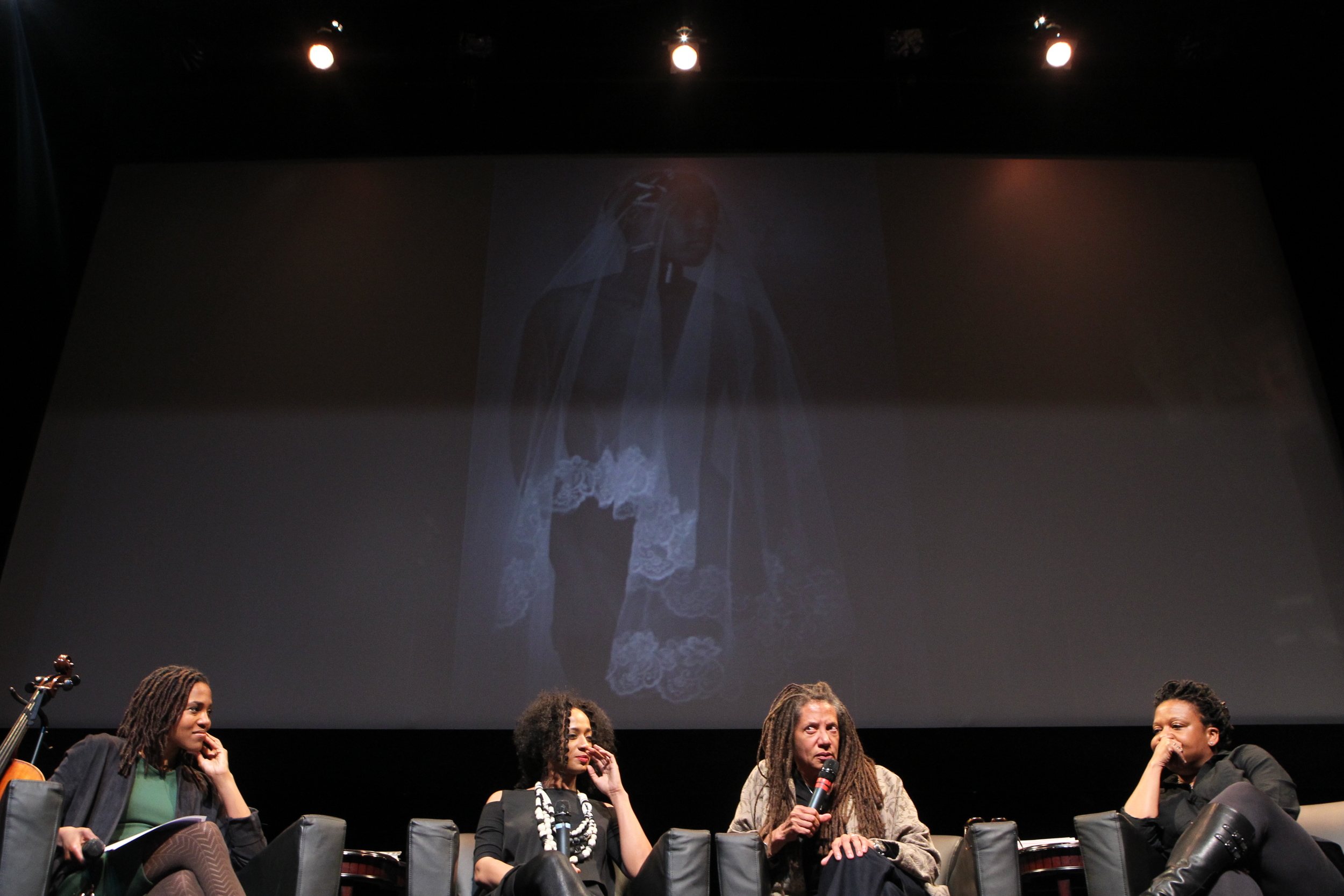
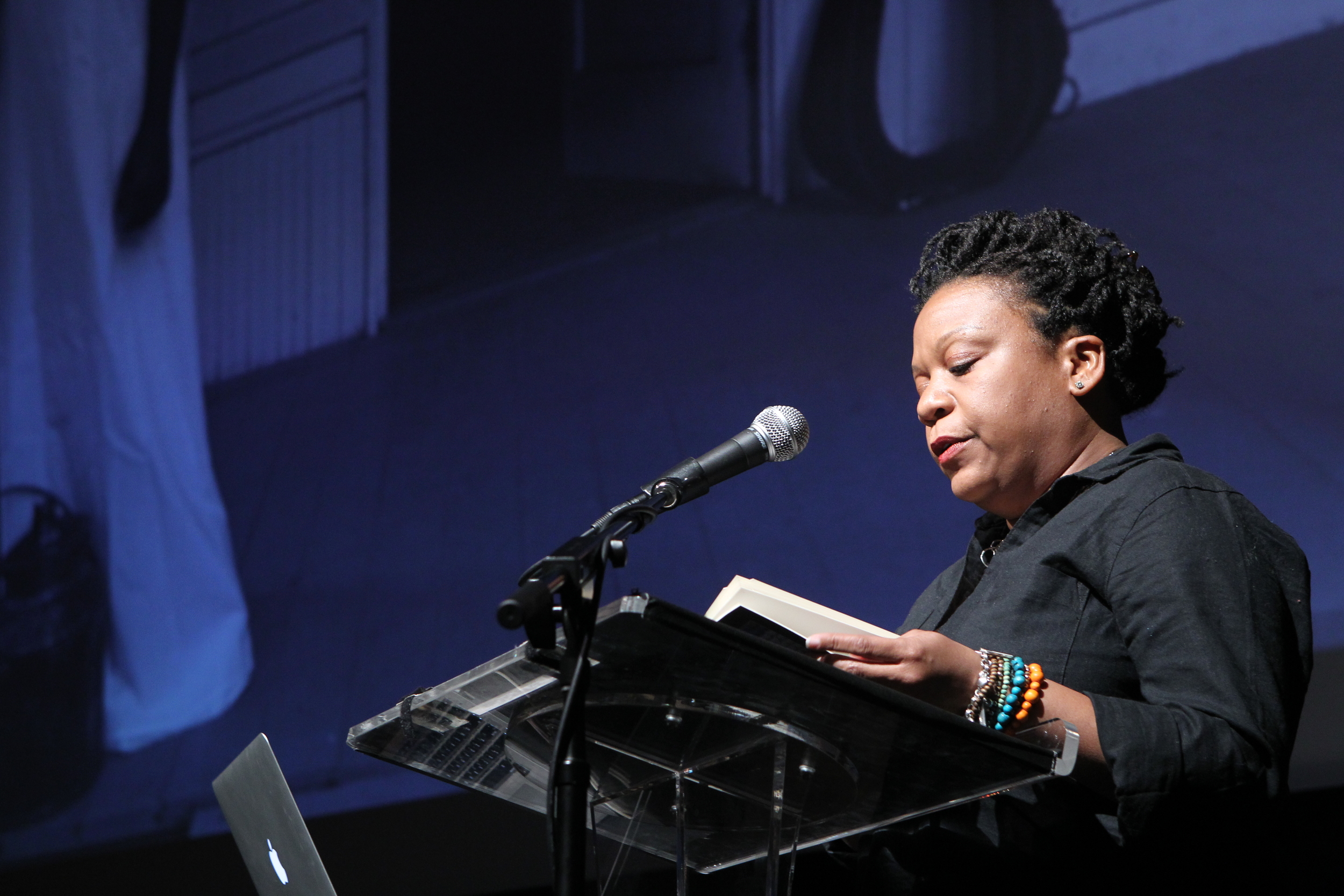
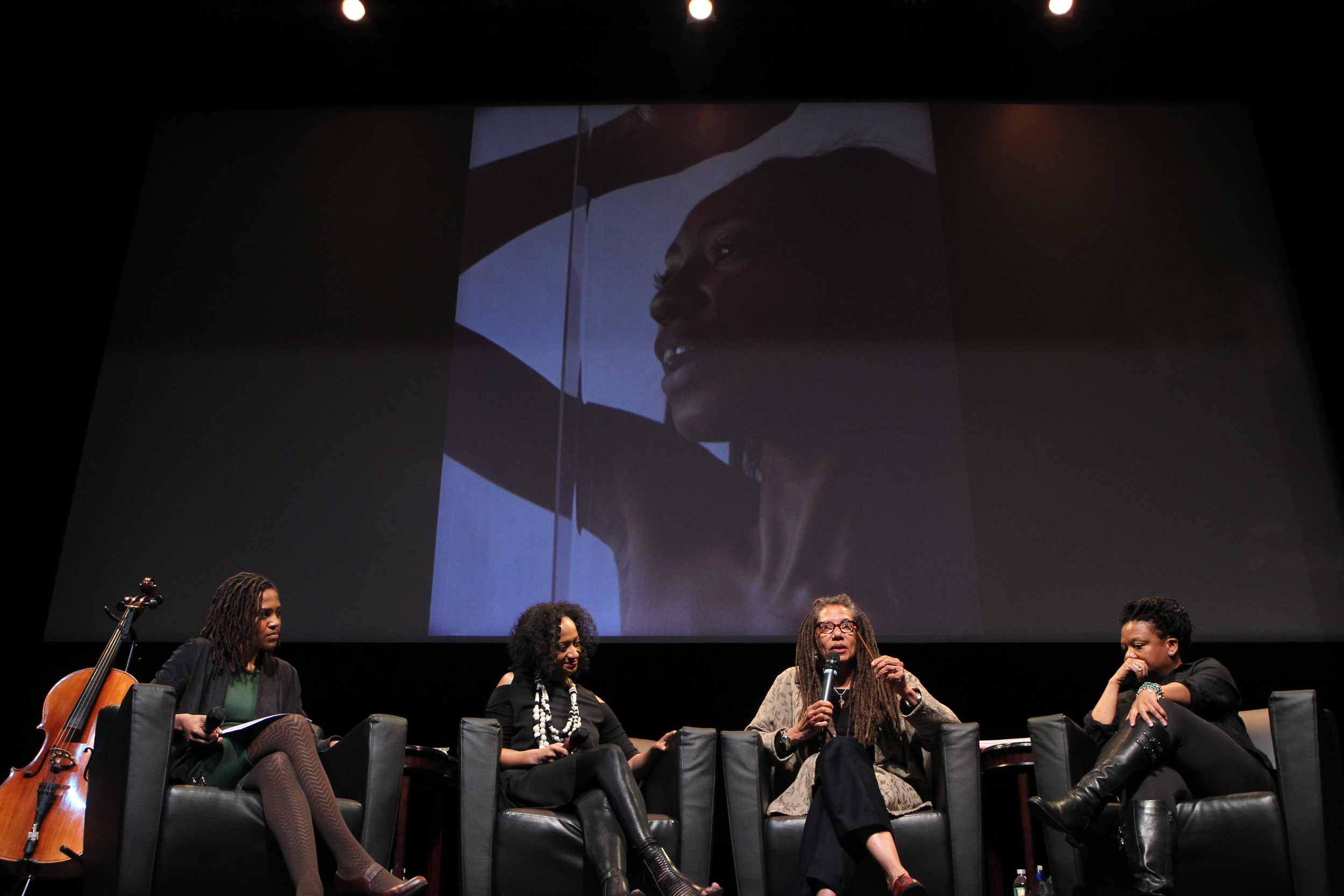
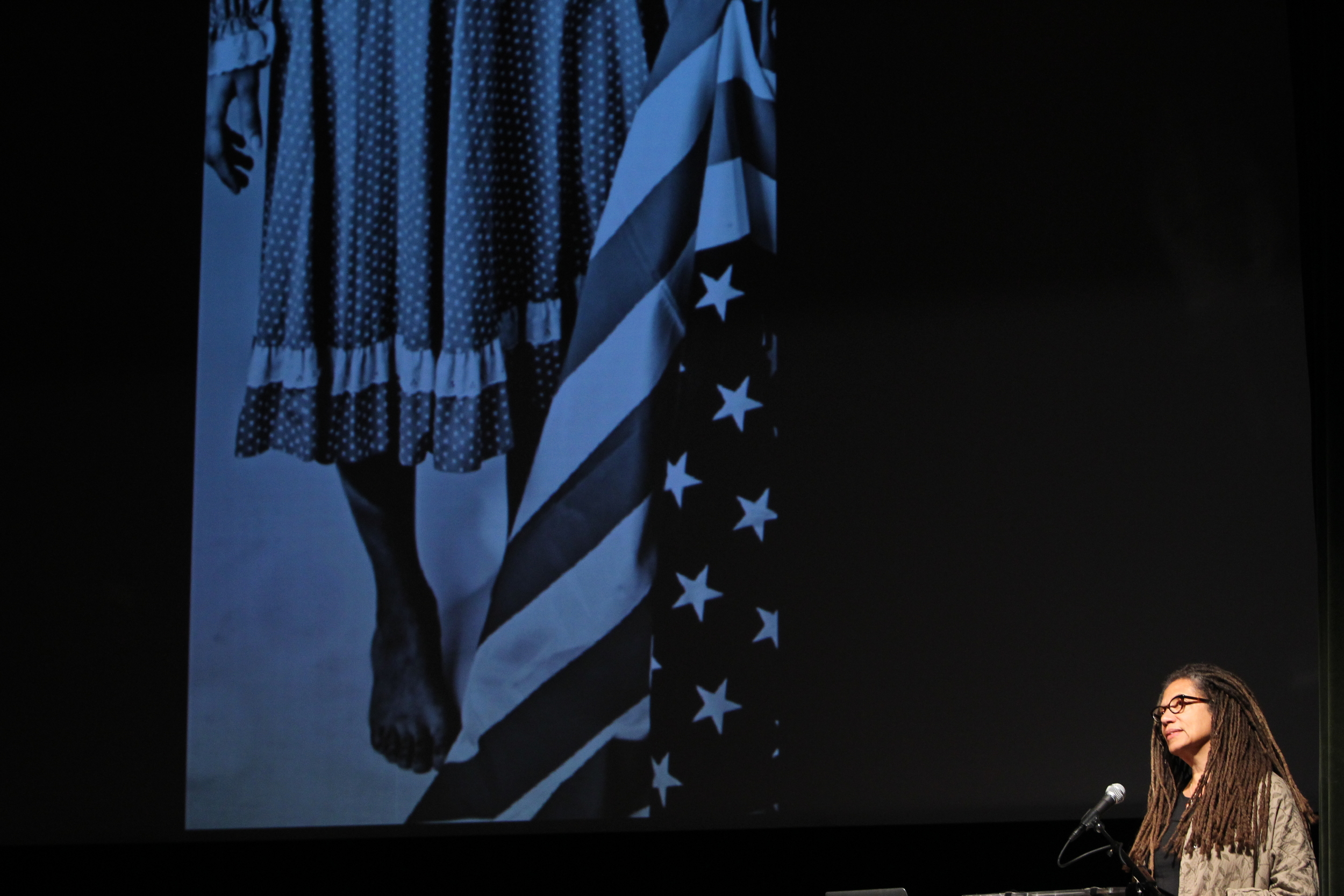
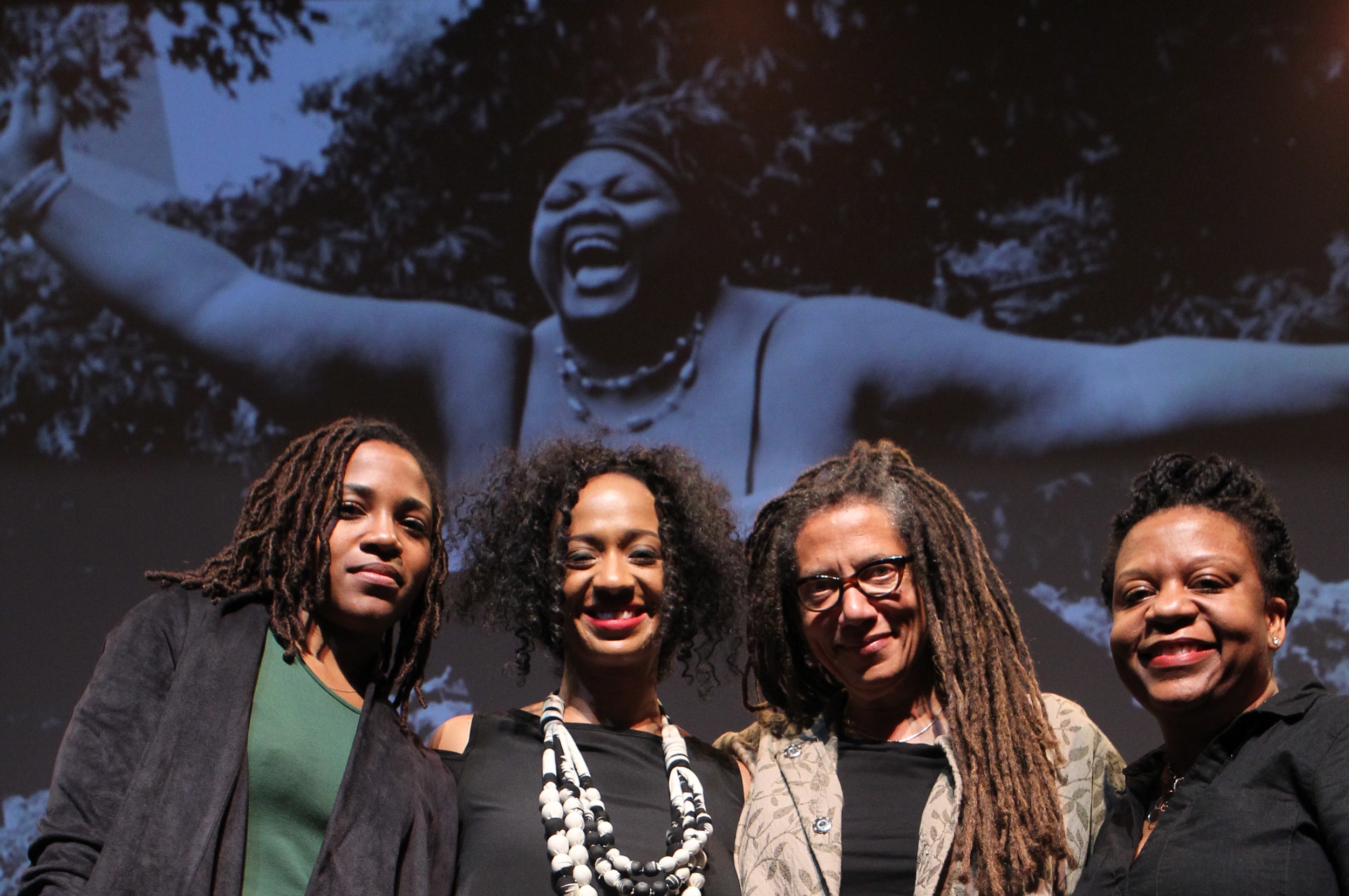
SARETTA: In preparing to come here tonight, I was looking at some of Deborah Willis’ work around beauty and black people and empowerment and her furthering the idea that the silencing of various kinds of beauty is actually a human rights issue. And so in writing and in creating spaces for different voices and different versions of life and beauty and pain to exist, I’m wondering to what extent you are thinking about that as a political act?
PARNESHIA: I entered publishing when I was 22 at Third World Press. They publish black people every day. So when I came to Northwestern, to say that there were no black people on the list, I mean, there were maybe 5, or 3 or something. But you’re talking about a press that has a 100 year history. So coming from Third World Press, a place where you have Gwendolyn Brooks, Sonia Sanchez, Gil Scott, . . . then going to Northwestern, . . . everything just seemed out of focus in terms of what was on the list. And so I just went into it like, of course the list should be more diverse than it is now. I didn’t think that I was being political about it. Everybody deserves to tell their story. I’ve been at Northwestern now ten years. And in the last couple of years that I’ve been doing poetry, we’ve published more black people, more people of color than the hundred year history before.
RACHEL: Parneshia talked about how she came into publishing and it made me think about how I became a photographer. I’m a self taught photographer and I have a visual arts background. But I moved to New York and picked up a camera because of the pace and rhythms of the city. Usually when I see black skin in front of a lens, it’s surveillance. It’s not what I see. It’s not that incubator of life, of touch, that Nikky is talking about. But then there is also the gaze. Toni Morrison has talked about writing away from the [white] gaze. As a photographer and as a poet, I’m writing for this gaze and that gaze. I make photographs and poems that I want to see. And I want to see a complexity manifest, especially where black women are concerned because I’m a complex black woman.
I won’t say that the camera is completely democratic. I used to say that. That anyone could hold a camera, that anyone could take a picture. But what’s interesting to me lately is the footage people have on their camera phones. This footage is now the evidence when crimes have happened. People would say what happened to Walter Scott didn’t exist. But here’s the tape, here’s the video, here’s the evidence. Here’s the planted evidence.
And so, I would like to plant some different kind of evidence about black women’s beauty and intelligence. Every one of these photographs is political, even though some of them are quite lyrical—including the ones of myself. If I take a self portrait, it’s in every single one of the women I am looking at. So there is a connection there that I think is important, and that connection doesn’t happen when someone else is behind the lens and wants to frame you.
The vocabulary of photography is so amazing to me and it’s so violent. ‘I’m going to shoot you. Point and shoot.’ It’s already aggressive and as a poet, I’m very sensitive to it. So when I say ‘Come over. I’ll shoot you,’ I have to catch myself and say ‘Oh no. We’re going to make a portrait.’ ‘I want to capture you’ is also part of the vocabulary. It’s a conquest. And it’s a matter of seconds. But in my poet self, I don’t want to capture you. ‘We’re going to share some time together.’ I couldn’t capture you in a second. I might get a likeness, but . . .
You can just see their worldview change because they’ve never thought about the options. And it’s the images, for the most part.
NIKKY: I’m finishing up a class I’ve never taught before, a class that I created this semester at the University of South Carolina on the Black Arts Movement. And in the history of the school, they’ve never had a course on the Black Arts Movement. It’s only 200 years old. But it’s been a really amazing class. Half the class is black and half the class is other. And all my black students say the same thing: ‘How come I’m 19 years old, how come I’m 20 years old, and you’re showing me Moneta Sleet photographs, or Morgan and Marvin Smith and how come we don’t know their names? And how come nobody told us the difference between the Black Arts Movement and the Harlem Renaissance, that hip hop comes out of this lineage of black creativity and they spin in the middle of the floor? It is intradisciplinary and interdisciplinary and so we’re studying Betye Saar’s art, we’re studying Faith Ringgold’s quilts. We’re studying the Black Theater. They had no idea about the power of the black theater. You can see them go from like this [slumped in their seat] to this, where you can see their spines triple in size. Because on the screen there are images of them that no teacher in their lives has ever shown them. We’re in the deep south, we’re not in New York City in Harlem, you know. We have one more class and they come up to say, ‘how can I get into the next class?’ The next class is a different kind of class. It is a deep reading class on Audre Lorde and James Baldwin. And it’s full because they are so hungry to see themselves somewhere and hear themselves somewhere. It’s a crime that they’re 20 years old and they’ve never seen themselves in this way in the photographs. And we talk about what happened when the Afro hit and what Ebony did, what Black Scholar did and how black people are different, how some are conservative and some aren’t. You can just see their worldview change because they’ve never thought about the options. And it’s the images, for the most part. Yes, it’s recordings. I put on James Brown’s I’m Black and I’m Proud and light up the whole nursing building. But they look at themselves up on that screen and they see their Auntie who they used to laugh at for having an afro. We look at Black-Eyed Susans, Mary Helen Washington’s amazing book. That book changed my life as a young writer. And so, I’m passing that on because that’s my job. But I need like 50 more soldiers. I’m serious. And when I talk to some of my colleagues, they’re a little frightened of doing that. I mean, I’ve messed up all semester in all kinds of ways. But I tell my students, ‘I’ve messed up. I’ll come back, let’s pick up where we left off.’ Because I’m a student too. But I don’t want them to get to 20 and not see and not know what I know.
RACHEL: You spoke about lineage and I want to say a bit more about that. I think there’s a difference when you know you’ve come from people, and that those people claim you and that that claiming does not need to be monolithic. That there is space for all kinds of claiming and growth and I feel right now, in a contemporary sense, there is so much lineage, especially where black art is. It’s a renaissance. I mean, you can go to Brooklyn Museum and see Kehinde Wiley and Basquiat. As far as woman go, Mickalene Thomas, Carrie Mae Weems, Deborah Willis, Lorna Simpson, Nina Chanel Abney, Xaviera Simmons. There is just so much blossoming. And it’s out. And it’s that Black cool. And it’s new and there is so much space. It’s very very powerful. Wangechi Mutu. If you bring that into the classroom, the classroom is everywhere. The classroom is everywhere.
But when I think of lineage, I also think of Lucille Clifton. I think of Dahomey Women. And I think there is a power for me as a photographer. Roy DeCarava, Gordon Parks, James VanDerZee. LaToya Ruby Frazier is an amazing photographer doing amazing work right now. And I don’t feel isolated and I see reflection and refraction and sliver and shard. And there is not this standard black woman who is stoic and invulnerable. No. There is so much more. There is that, but there is also vulnerability and intelligence. And at least for me visually, it is trying to get that interior narrative. This often happens to me as voice in a lot of the photographs, especially the ones that I did this past summer down in Oxford, Mississippi. It was voices. Channels were open, and in the South the past, present and future, as you all know, is all immediate. So I might go into a cabin with some models and someone says, ‘well she has to stand over there.’ And I say to the model, ‘you have to stand there. I don’t know why. But you have to stand there.’ And that is a separate kind of feeling and knowing than the technical, mechanical, making sure the F stop is right in the camera. I feel as if there is a haunting that can come through the lens because there are still conversations that are happening in real time, on a number of frequencies. They’re happening. And this interests me, kind of spirit photographs. And I was just thinking of the Harlem, . . . what is the book, . . .
NIKKY: Harlem Book of the Dead.
RACHEL: Harlem Book of the Dead with . . .
NIKKY: James Van Der Zee
RACHEL: Yes.
NIKKY: And Langston Hughes.
RACHEL: Langston Hughes and Roy DeCarava, The Sweet Flypaper. All of that.
PARNESHIA: I wish I had a pen. (laughter)
Just the picture of a woman holding a camera is revolutionary. It’s revolutionary. It is political and I want it to be. And so you get that behind your eyelids. You go to sleep with that and you think, can I do that?
NIKKY: The other thing that is really, really important for me is giving my students permission. I bring a camera into the classroom and for the first five minutes I’ll stand there and make them very uncomfortable because I’ll take their picture. And I’ll say, how many of you have ever seen a black female photographer? And no hands will go up. And I’ll bring some. I’ll bring Deborah Willis. I’ll bring Jeanne Moutoussamy-Ashe’s pictures and other people. And just the picture of a woman holding a camera is revolutionary. It’s revolutionary. It is political and I want it to be. And so you get that behind your eyelids. You go to sleep with that and you think, can I do that? I know that happened to me when I saw a black woman holding a camera, not just a little brownie, but something more substantial. And I could figure it out autodidactically. Like you, I didn’t go to school for that. I made a lot of mistakes and then I started taking notes with my little pencil. And you get some things right, and you get some things wrong. So one of the final projects in the course, . . . all the white students are writing term papers and 75% of the black students want to do something creative because they’ve never had the opportunity to do something creative. They’re making films. They’re putting together a photography exhibit. They’re doing actual pieces of art. It has to be framed, it has to be a certain size. It has to be accompanied by a five page essay. But they’re like, ‘no one has ever given me the opportunity to do this.’ Because art is out of the schools now. And so, I give them the option. They can write or they can do that. And with a lot of my black students, I have to figure out a way to make this fair. Because they didn’t come from the private schools where their parents paid $20,000 for them to have a certain kind of English teacher in their lives. They didn’t have that. And they didn’t read the same books that the other half of the class did. So I want to give them creative projects that also hold their feet to the fire narratively, but also the experience of creating something with your own hands. Pshhh. Get outta here. [Laughter]
SARETTA: I think we have a line developing at the mic.
NIKKY: Oh, . . . a line.
RACHEL: Yay!
AUDIENCE: This is a question about photography. I think when you’re making a photograph and all of your personal experience, and all of your values are behind your eyes, in the gaze, so much of that is like forcing perspective on the frame that you make. I wanna know, like, how much of that do you leave behind for discovering something new with the camera?
One of the landscapes I ended up photographing was Rowan Oak, which is the William Faulkner estate. And a woman of color, Caroline “Callie” Barr Clark, took care of Faulkner and his family for many generations and had a cabin back behind the estate.
RACHEL: That is an amazing question. Thank you. I’ll say briefly, because this continues to be fluid and shift and it’s not static, . . . a lot of things will affect a shoot or a mood for me. If I’m photographing a writer or a poet, I always have read their writing in advance because I’m trying to make a portrait. But their portrait, how they exist is in language and in words. So if I don’t at least read their words, I can’t see them. So I have to start there first before they even come into the studio.
If I’m out on a location, landscape really comes into play. I spent a month and a half this past summer down in Oxford, Mississippi photographing in different landscapes. And one of the landscapes I ended up photographing was Rowan Oak, which is the William Faulkner estate. And a woman of color, Caroline “Callie” Barr Clark, took care of Faulkner and his family for many generations and had a cabin back behind the estate. There was the big house and then her cabin. And I was permitted to have models and light and to go into her cabin and shoot and work all over the Faulkner property and kind of bring a new narrative, literally, to that story of Faulkner, Oxford, Ole Miss and all of that. I think one of the interesting things that happens with me when I photograph black women is that they aren’t prepared for another black woman to see them and to accept all of it. And so we begin, and they pose. And I’m waiting and they’re not hearing the camera click. And I’m waiting. And they’re kind of like, . . . is there . . . what, . . . what . . .?
PARNESHIA: You did that to my mother.
RACHEL: Yes, I did. [Laughter] Yes. And so, there is this fixed face. But that’s not the face that’s going to make this a photograph. So I’m going to be patient. I say “put this white dress on” and they’re like “what, . . . what’s going on?” And then they soften. Every single time, they open. They’re expansive. I noticed this when I was younger and did a series of women in trees. I was engaging a different conversation back then. Black men in trees have a certain narrative historically in this country. But what would happen with a woman in a tree? And so when I asked the women to get up in the tree, . . . some of them, they would give me the side eye, and they should. [Laughter] But then they would do it, and you could see what they looked like as girls. You could see, ‘oh she just wants us to be ourself.’ And they would get up in that tree, . . . I mean, kick their shoes off. And then they’re off the ground. They’re in air and they don’t have to be the way they are when their feet are on the ground. But it’s an amazing gift to even be present with another human being and have this exchange.
NIKKY: I just have a quick answer to David. David, that guy right there, he’s an amazing photographer, filmmaker, videographer. If you look up any video online of Nikky Finney, this is the man who shot it right there. Shot it. Yeah, see. I’m using the same language. But I gotta say this to you. Willa Cather said that by the age of fifteen, every human being who is some sort of artist, will spend the rest of their lives writing about what they know to fifteen. Everything you experience from birth to fifteen, is what you will spend the rest of your life writing about, making photographs of, making films of. Like that. And so I tell this to my students all the time and they go, ‘No. Fifteen? Eighteen was when . . . ‘ So don’t get locked into whether it was 15. What she’s saying is really powerful. You know love. You know desperation. You know abandonment. You know all those things. And so as a photographer, all that stuff is behind you taking a picture, because the picture is as much a photograph of what you’re looking at, as who’s taking it. And that’s good, for the most part. That’s as it should be. Don’t stop that. I think that’s really the power, especially with my relationship with you. I know that. But it’s when you continue to do the same thing, set up the same shot, that’s when I say to myself, “well, let’s go over there.” And that’s what Rachel is saying about a different landscape, or a different thing. But voice or trusting what you see to be the photograph you want to take, that’s important. And I think that we as people of color who have been told many, many, many times, ‘that’s not a photograph. That’s not a poem. That’s not a story. That’s not a . . . that’s not a , . . . that’s not a . . . that’s not a . . .’ Trust yourself. It is.
PARNESHIA: I just want to say I brought my mother here to New York City for the first time when Rachel shot both of us. Rachel was gracious enough to come to the hotel where we were staying.
NIKKY: Did portraits of, . . .
PARNESHIA: Did portraits. Captured portraits. Illuminations. [Laughter] And this was four years after her oldest child has passed away. And this was the first time she had been on a plane since before September 11th. So my mother was in a state of calamity, I’ll call it. And so I had asked Rachel to come. They had never met each other before. And it was so interesting that you asked that question, David, because I had thought about it while you were shooting my mother, that this is the first time she was photographed by a black woman. And all of the insecurities came out. Because I remember the shoot. The hotel was very gracious and let us have the top floor. And my mother was sitting there in the chair. And Rachel was taking her cameras out and everything. And I said, ‘Mom, I want you to just have some shots just by yourself.’ And she refused to look at you. She was looking all around and she was so straight and she was so stiff and kept taking these deep breaths. Rachel is patient as ever. And so finally I just came over to her and kissed her on the cheek and started talking. And there was just something that happened. All these different women that my mother is came out in these photographs. Mother. Woman. Wife. A woman who has had children, a woman who has lost children. A woman who has been on a plane for the first time in 12 years because she promised she would never get on a plane again after September 11th and her first trip was to New York City. All of that came out in these pictures. And so I think that was really a powerful thing where you turn insecurities into art and power.
All these different women that my mother is came out in these photographs. Mother. Woman. Wife. A woman who has had children, a woman who has lost children. A woman who promised she would never get on a plane again after September 11th.
AUDIENCE: There’s Lorna Simpson, Carrie Mae Weems. There are all these wonderful people. All this work. But somehow there’s this blind spot where we don’t know. We’re not coming to it. Why does somebody have to reach the age of 25 and be Afrolatino, or West Indian, or African American or AfroIndian and just hear Gwendolyn Brooks for the first time? How do you feel about this blind spot?
NIKKY: It’s not a blind spot. It’s on purpose. I have to jump in because you can’t say it’s a blind spot. This is on purpose. It’s deliberate. This is what I tell my students. You don’t know your history because somebody said if they know that history they’ll become smarter, they’ll become powerful, they will take me on when I say the wrong thing in class. This is deliberate. This has been going on since they used to kill us for holding something like this [pencil]. Black codes. South Carolina. You get caught with a pencil, you lose your hand. What does that say? That’s powerful. It’s not a blind spot.
AUDIENCE: One of my best friends was on the admissions board at Duke. He’s caucasian. When I was doing MFA applications I asked ‘what’s going on?’ There are people who are applying and who aren’t getting in.' He looked at me and said, ‘They do it on purpose. They let one in on purpose and then they reject the rest on purpose because they are looking at how you mark your application.' How do you teach young people, even people who are just coming to their artistry with that ‘on purposeness?’ How do you train yourself? Prepare yourself? Convince us that it is worth going through.
NIKKY: The first thing is it starts with you. Do you think you are valuable enough to know who you are? Part of what the big battle is so many folks don’t think they are worthy of what I’m talking about. The lessons have gone in and have made and matriculated universities of worthlessness inside of individuals. And so you have to hit that like, “what do you think would happen if you knew you came from kings and queens? What do you think would change about the way you walk down the street or when somebody calls you a name?” So all those kinds of things, that’s where you have to start with the human being, with the body, with the spirit, with the soul first. You have to say, you are going to meet some bad teachers in your life. And they’re going to tell you some horrible things. What are you doing to counter that?
You know, my great, greatest teacher gave me the best lesson. Saw me sitting on the wall and said “have you read all the books in the library, Miss Finney?” And I said “All, Dr. Gales? I mean like all?” And she said “Yeah, all. And if you haven’t, let’s go. Get off the wall.” I think about that when I’m sitting around going, what can I do? It’s a Saturday night. Do I drink this glass of wine or do I go read James Baldwin. I mean, sometimes I drink the glass of wine. Many times I go read James Baldwin. [Laughter]
AUDIENCE: Sometimes you do both.
NIKKY: Yeah, sometimes I do both. But as Baldwin said, you know, when you’re working, when you’re writing, you don’t drink. You do that later. If you read, the people who have come before us have left the lesson plan. Have left the path. Have left the lesson plan. We just don’t read it. We don’t know the biographies. Audre. I mean, this is what Rachel is talking about with this Black Unicorn. All the stories are there for us to do what we need to do. We just don’t go to the Schomburg and spend five weeks studying it, or five hours, or five minutes. It’s here. This building is a sacred, sacred space. We should be coming up here by the busload from every port that we can. This is the depository of so much of who we are.
PARNESHIA: I just want to say also that you have to be on purpose. If they’re on purpose, then you be on purpose. The first opportunity they gave me to acquire, I said, ‘Hello beautiful black woman poet, would you like to publish at Northwestern? I’m a black woman.’ And we'll hold on to this woman for as long as possible. You have to be on purpose. You have to kind of move about with a sense of purpose. And like she said, we have all the artillery we need and we’re still creating more every single day. So just be on purpose. They are. Why can’t we be?
NIKKY: Quick story. Lucille Clifton. Called the N word when she was 25. I’m interviewing her. I said ‘Miss Clifton, you were called the N word at 25? What did you do?’ I said, ‘Before you tell me, when I was called the N word I was 12. I was walking to integrated school and the boy called my brother the N word and I took my backpack and I beat him upside the head and I got in trouble. And I said ‘did you do that?’ And she said, ‘No. I just realized that that person who looked like that from that moment forward would be unreliable.’ I said ‘what?’ (laughter) ‘Unreliable? That’s it?’ She said ‘when you mark somebody as unreliable, that they cannot give you any information for yourself to be better in this world.’ I said, ‘unreliable.’ (laughter) Tell that story to somebody. To say that somebody is unreliable, you have to make a decision. You can’t say, oh they so nice. They got a bald head, they got a kind heart. No. You say that person is unreliable. They have called me a name that I am not, therefore I am going to go someplace else to get my information to be who I am. That’s what she did, for the rest of her life. Autodidactically, she went to the stacks. ‘Cause I’m not a nigger,’ she said. So if somebody is gonna call me that, I’m gone. If you meet some unreliable people, keep moving.
AUDIENCE: Good evening. I just want to tell you that I’m in awe. This is the best treat ever! I just walked into something amazing! I truly believe that nothing happens by chance and I’m in the process of working on a community forum for black women and the topic is “How do we Save Our Last Nerve.” So, two part question to each of you. How do you save your last nerve? And could you please speak to the masks black women wear and the curse of being strong all the time?
Because as my grandmother used to say, ‘black men end up in the prisons, and black women end up in the state institutions.’
PARNESHIA: Can you say wine? Wine. (laughter) Seems like the easiest route. I don’t know. I think that for me, I’m trying to be as literal about this as possible. I’ve kind of made my space at home where my last nerve is kept. It’s not actually with me. I live in Chicago, with a panoramic view of the skyline and the water, because I have to be near water. And I got all of these old Jet magazines from the 50s and 60s, spread in my kitchen, in my office. All of these different photographs and postcards. And I have bottles and bottles of wine. And I just got a new couch. [Laughter] And let me just tell you. I bought this couch specifically for naps, because I’m not a good sleeper. I only sleep on the weekends, like really sleep on the weekends because I travel a great deal for work and for my writing. But I come back just to touch my last nerve. Just to hold it for a little while before I go back out in the world. I don’t carry my last nerve with me. That’s not a smart thing to do. I’m always misplacing my keys and everything else. But my space. I have made my home the most sacred and the most safe place that I can be in this world. So that’s for me.
NIKKY: I want to say something about language and black women and I don’t really know how to say it. I know what you mean by last nerve, but I personally, . . . I need four nerves. I just can’t get down to the last one because I’ve been told that that’s what we do. And I refuse. Every time somebody says black women have to bear the burden of the world, I think of Zora, . . . and I refuse it. I think sometimes we perpetuate the stereotype in a way that we don’t mean to. But we do because, . . . I don’t know, . .. it makes us smile. It makes us relax a little bit. But we do not have to carry the world. We cannot carry the world. We can’t pass that to our daughters about carrying the world. Even though we carry a lot. But we have to at some point back up and give ourselves room to weep, and hold each other and say ‘I can’t do that.’ Because as my grandmother used to say, ‘black men end up in the prisons, and black women end up in the state institutions.’ So I have to refuse those kind of ‘last things.’ That’s just me. And I’m looking for new images, language. I don’t know if that makes sense, or if I’m being persnickety, which I can be sometimes. But I want permission for something new.
AUDIENCE: I think in response to what you’re saying, that is the whole purpose of the dialogue that I want. Dealing with mental health and mental illness, that we shouldn’t have to carry the weight all by ourselves, all of the time. And even though that is a phrase that we all can identify with we don’t have to wait until that last nerve. We should be proactive and say, ‘you know what. Time out. I’m doing me. I’m going to delegate.”
NIKKY: Yes, so I need a subtitle. Dancing on my Last Nerve, colon, Doing Me. Let the carrot be not the stereotype, but also the black future, you know. Bring that in, the promise of what we will build together. Because if we just look at what you’re talking about, that dancing on the last nerve thing, it doesn’t go far enough. It doesn’t have the magical realism, the imagination, the passion, that ‘this is not going to be the old story, y’all.’ Bring the new stuff in with that. The first thing, I understand it. But at some point, you have to go beyond it. And we have to do that. We can’t call each other together under the old rubric, the old name. You know, Audre told us we can’t dismantle the master’s house with the old, we need something new. And so we have to trust that on that colon, we’re gonna have enough light and sunshine that the sisters will come. And they will come.
RACHEL: And just to add a tiny postscript to that. When you’re on the last nerve then you have nothing after that. And so, when you’re on the last nerve, who is going to build you back up? How long is it going to take you to get off your knees? So getting down to the last nerve is kinda like your last pint of blood, where the body can’t feed itself, and it can’t feed anyone else. When you’ve allowed someone else, whoever it is, including sometimes loved ones, to get you to that point, . . . it’s not acceptable. I wouldn’t drive out to the desert on my last piece of gas and not know there is another gas station. I wouldn’t leave myself stranded. So when you get to your last nerve, you can leave yourself stranded spiritually and then you’re spiritually broke. You’re physically broke. If you do not have your health, you have next to nothing. You have your spirit, but your spirit’s in a body right now. I think there is a kind of starvation that can happen to you spiritually and creatively when that happens. And I think there is enough in the world trying to do that already.
NIKKY: Because the eyes are here and not there. And the eyes got to go there. Because we’ve been there.
AUDIENCE: Hey y’all. I’m wild nervous, so I wrote down my question. This is incredible. But in terms of ancestral memory, what you were talking about when you’re in that cabin in Oxford with the model and you say ‘you gotta stand over there.’ That memory, . . . that unnameable knowing that we all tap into, I think, when we create. I wanna know, is that teachable? Can that be taught? To what end? And is there an end we care about living in or leaving behind? And that would then tie in with the language to teach it, this possibly unteachable thing. With the camera, this old language of ‘shot, capture,’ like hyper-colonial speak that I know really ain’t ours to begin with. When we adopt it, in adopting it as black women with cameras, is that a subversion enough? Or do we need to adapt the language itself for it to actually be of service to us? Is it enough that I am a black woman that can capture? Is it enough that I am a black woman that can shoot? And then in terms of teaching this ancestral memory, if we can, and with what language? Are we interested in developing a language and does it matter who it’s for?
RACHEL: That was like 75 questions.
NIKKY: 85, . . . 85 [Laughter]
RACHEL: 85 questions.
AUDIENCE: 96 questions. It’s a very exciting place to be. [Laughter]
RACHEL: I’m just trying to hold on to one question in my mind. Again, when I went down to Mississippi, I had to learn a new vocabulary. I’m coming from Brooklyn down to Oxford, Mississippi. Coding. Language. All kinds of things happening and one ‘bless your heart.’ I learned that has a whole lot of meanings in it, you know.
When I think about ancestral memory, I’m thinking about spirit. And I’m bringing spirit through the lens as much as it is coming and looking back at me. So I have to honor that and I can’t ever be reckless with that. And it happens frequently for me. I will really see eyes looking back at me that I know are 200, 300 year old eyes even though the person standing right here was born 30 years ago. There is something coming through, if you speak for it, if you call on it and you witness it. But again, it is not monolithic, one source. It is from everywhere, which gives it it’s air to survive so much. To survive oceans and ocean floors, ships and all kinds of things. And it is that imagination. I think people can be taught to nurture and feed imagination, but it is so individual and nuanced to try and say anything static. Because we are not static.
PARNESHIA: I’ll also just grab a piece of your wonderful question. The whole idea of this new language, I think, is that if you agree to tell your story you’re writing a new language. I mean, you’re writing something that no one else is in a sense and that’s a new language automatically. Whether you are writing it, doing it through film, through photography, if you are making that conscious decision to tell your story, I think by default, you’re creating a new language.
NIKKY: I speak a lot out of the I voice. I always have and I always will. And I have found, as the gray hair continues to appear magically on my head, teaching—and Rachel is wrestling with that—we think that there is only one way to teach. Or we get wrapped up in the high definition or the one definition of teaching. Most of the time, I want to go home and close the door and not come out for like five years. My first spirit is a quiet, under the floorboard, almost hermit kind of thing. I can’t do that because I have been passed so much. I come from a generation and from people who said ‘unto whom much has been given, much is. . . . You know. I got that. It’s tattooed on my back. So I can’t go home and close the door. I am a child of Toni Cade Bambara who said on her death bed to me, ‘Nikky, do not leave the arena to the fools.’ One line and she died a month later. What am I supposed to do but go out into the world and open my mouth. It has been passed. So yes, I am teaching by the book, conversations, papers, projects. And I’m not trying to be a role model. I don’t do that term. But I am trying to step out and not leave the arena to the fools and show my students of all ages, because I have some 60, 70 year old students in that class too, that you can take on the Old South. You can stand up in the spirit of Modjeska Simkins, Civil Rights icon and keep that going. And we have to do that by skin and breast and bone. I can’t just write the book. I have to go out and do it and sometimes I don’t feel like doing it. But there is somebody waiting to see me do it, just like I was waiting to see somebody tell me how to become a poet. So teaching, oh you can teach it. You just have to make sure you understand there are 50 different ways to teach it. And everybody is not going to pick it up and run with it. You don’t know who is going to pick it up and run with it. But somebody is going to pick it up and run with it. And then they’re going to drop it at someone else’s door. So you have to believe that it can be taught. It was taught to me and not out of a book. Not out of a book.
AUDIENCE: My name is Nadia and I’m a poet and new to photography. I’m trying to find my way with that medium. I had a very strong response to the photographs, in a good way. I’m interested in what happens before you get to these locations and you take these photographs. How do you come up with these different stories or projects that you’re working on and different messages that you are trying to get out? Also, as a poet and photographer, how do those two worlds come together or not come together for you?
RACHEL: Thank you, Nadia. They’ve been coming together more than when I was younger. Before they really were repellent. This part of the self does poetry and that self over there does photographs and makes images. But now, they are more like Siamese twins, or like hyrdra or a Wangechi Mutu painting where they are just all symbiont.
When I first starting photographing it was more fine arts creative, really just pulling out of my imagination. I was too shy. So a lot of the models I used were poets, sisters who were kind enough. I wouldn’t have thought about having a model that I didn’t know and trust get involved. I want to give a shout out. Nina Angela Mercer is here. She was my sister in the Silent Syntax video. This lyric video wouldn’t have had that energy if I had just got on a site and cast a model. I would have had to explain too much and it wouldn’t have had that effect. As I said before, I’m self taught. And even as a poet, I studied photographers and visual artists. I would make creative dates in the same way that I might go to a scheduled class or show up at a job. My job is to show up at a museum. My job is to show up at a film. My job is to go back through archives, to look at documentaries, to feed that spirit and see in which ways there is going to be these collisions and conversations and meldings and meltings.
And so some of the photographs are very surreal or have a magical realism effect. Some of them are about black skin. They’re about more than that. Some of them are conversations that I’m having with events that are happening in our times. I was thinking about Toni Morrison’s line in Beloved, “You have two legs, Sethe, not four.” And I thought about how I could convey the haunting in that novel. How could that haunting happen visually?
Do not give up. If I listened to the first person who said ‘well you didn’t go to school for photography. You’re not a photographer. Do you know what you’re doing with the lens?’ I would have a can of pickle juice right now. [Laughter] So I just went for it and looked around and just leapt and trusted myself. And I love what Nikky was saying, to know that you are enough. I love Audre’s question: I have come here to do my work. Have you come to do yours? That is on my writing wall. I have work to do. It’s been years now, but I remember when Nikky first wrote to me. It was about photographs. And she said, ‘We have work to do. You have work to do.’ I printed that letter out. I had a copy in my purse to carry around. I had a copy on my wall. Had a copy in my kitchen. So that I couldn’t forget a mirror to see myself. Because in these pictures that I was seeing elsewhere, I was invisible. No I’m not. No you’re not. No, we’re not.
NIKKY: Yeah. Quick thing that photography can teach the poet in you, if you want it to. So I’m the little girl at the farm, up in the barn. And there’s a little trunk that I’m not supposed to go into. My mother has told me don’t go in that trunk. That’s Uncle Billy’s trunk from Vietnam. Well I go in the trunk. And I find girlie magazines and x rated pictures and stuff like that from his time in Vietnam. And I also find seven camera lenses. Nikon F, manual. There is an underwater lens. There is a telephoto lens. There’s a wide angle lens. There’s . . . . something else. So what I do is I put the lenses on the camera one at a time and I go ‘I can see the bee on the cow’s ear with that one. I can see the whole farm with that one. I don’t have any water, but I bet you I can see underwater with this one.’ Underwater is magical realism. When I’m writing close and I want to see something, say just Rachel’s face, I go telephoto as a poet. When I do the whole room, I’m wide angle. I pull back as a poet and I want to like narrate, you know, expository writing. Photography taught me that. So technically you can do the same thing with writing that you can do with photography. Photography has all these very specific things that you can teach yourself and you can use those in writing. Writing has very specific things that you can use for the metaphor in the camera. So there are two beautiful, very lovely dances where the two can go. Learn the technical stuff, as my teacher taught me, and then break the rules. Learn the rules and then break the rules. So don’t be undisciplined. Be disciplined about learning what that camera can do and then break the rules of that. And then use the interdisciplinary together and you will create stuff that you never imagined that you could.
AUDIENCE: I’ve also written my question. As a primarily identified writer, I’m often inundated with the pressure to move into more feasible mediums such as film or music as books or textual literacy fashion out or libraries close. What is to be said of what it means to write, to be read, to read or even to feel the material of a book, a picture, etc.
PARNESHIA: I’ll take that one. That’s a really really good group of thoughts and questions. There’s this constant debate about the state of the physical book versus the electronic book, the libraries, the independent bookstores. Whether people of color, whether their stories can sell in the publishing world. And the answer to all of that is black editors, black librarians, black bookstore owners. That’s my answer. If you want to see your work out there or people who look like you, then you need to see people who look like you who make the decisions to put that work out there in the world. That’s the answer. At least that’s the answer I’ve come up with in working in publishing, and especially in academic publishing where it is very very difficult to find a person in charge who looks like me. So our stories are just as important. I think that’s what we’ve been trying to say all evening. Our stories are just as important as anyone else’s stories regardless of color. But the way to see us floating out in the mediums is to be behind the lens, to be behind the bookstore counter, to be that acquisitions librarian and to be that editor.
NIKKY: To go hand in hand with what Parneshia just said, before you get to her you gotta deal with yourself. And you gotta deal with the people behind you, all those editors, those 10,000 editors on your shoulder saying, . . . What did you say? When you going to go to a more viable medium? What was the word you used? Feasible. (pause) Writing is feasible. You just have to think it is. For instance, you have a book like Citizen that comes out. Claudia Rankin’s book. And it’s got all these images alongside the text. It’s really inventing a new kind of form. And it is a book that, I’m sure in her heart and head, required that. Lucille Clifton’s Generations. You cannot separate that amazing text from those photographs. That book gave me permission to create Rice, my book. Photographs. Poetry. But every book doesn’t have that dualism. Some books are just writing. Writing is enough, darling. Writing is enough. You don’t have to have the images and you don’t have to have somebody saying ‘You gotta move into the 22nd century. Come on, get with it.’ Words are enough if you work hard enough on them. It just has to be enough for you and you gotta get everybody off your shoulder. And sometimes you may want to do something with images. But don’t let somebody convince you that you have to. That’s criminal.
RACHEL: Saretta is encouraging me to give closing remarks. Thank you is what I want to say. Thank you to the Schomburg. Thank you to Kweli Journal. I especially want to thank our sister, Laura Pegram, who has worked so hard. And Nikky and Parneshia and Saretta and Mel and just all of you. We’re all going to go away into the evening with much to carry, for years really. So, I wish you safe travels home. And I believe we’re signing books. And I think if there are still things to eat, all of that goodness, and conversation. Thank you again for coming out and supporting.
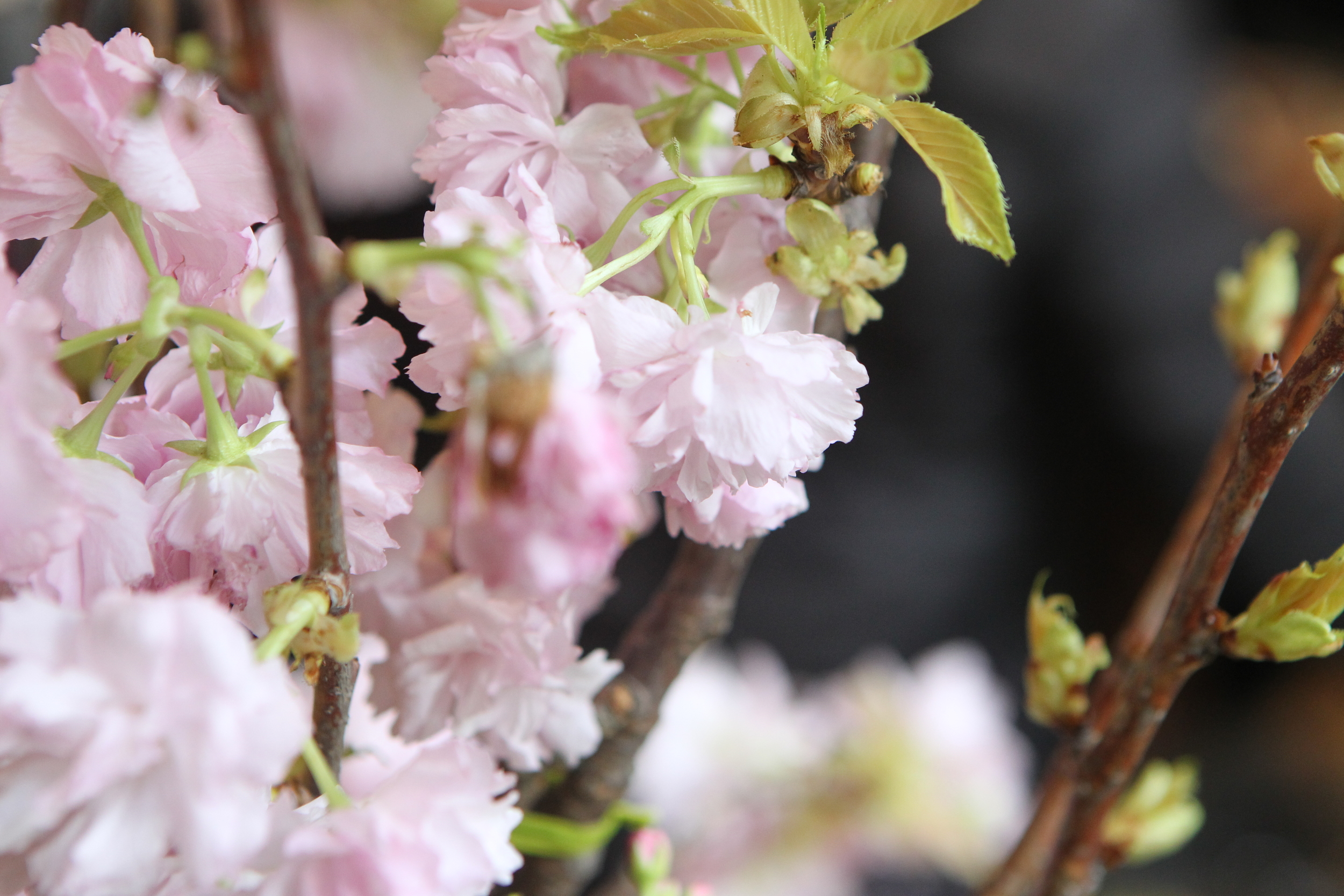
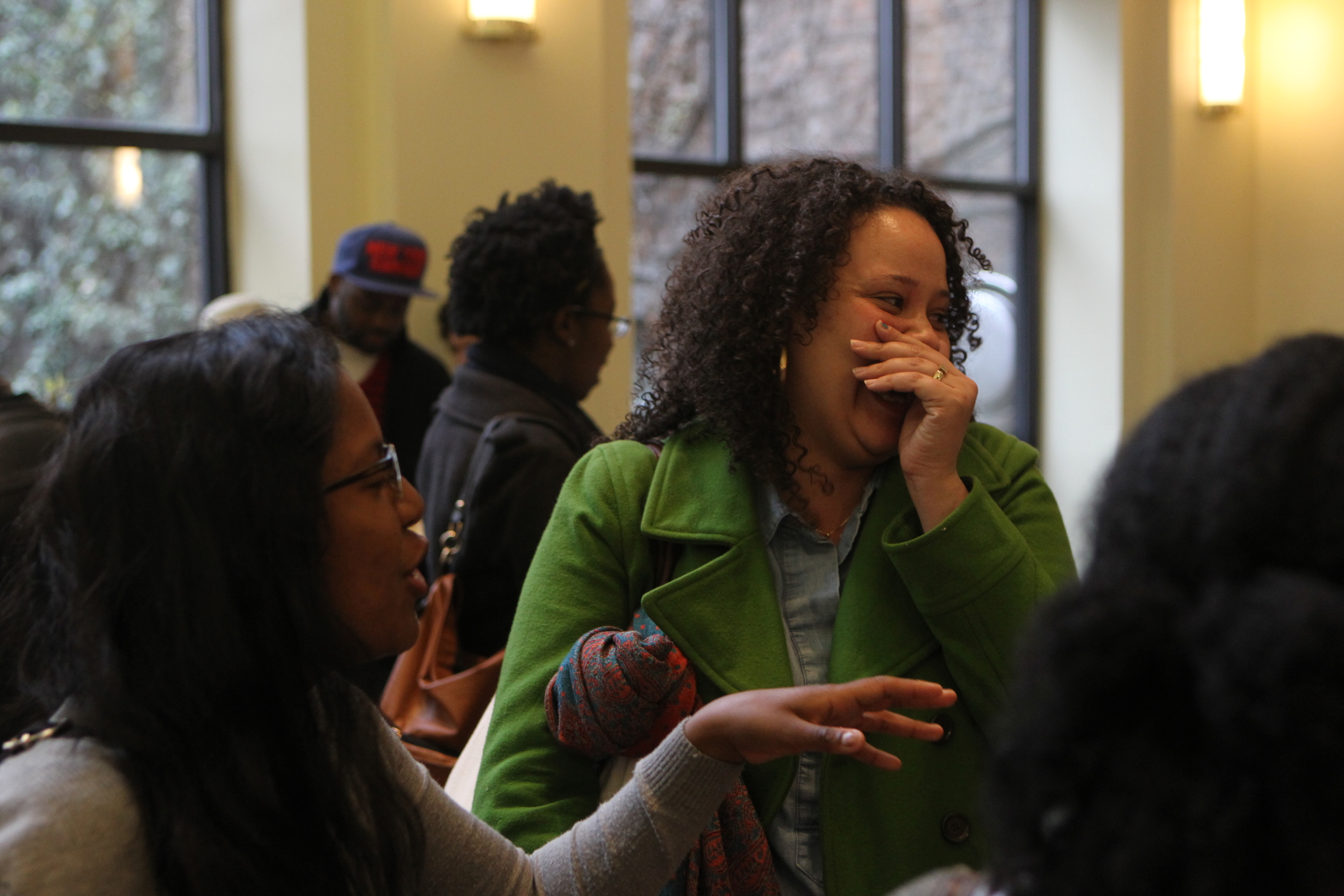
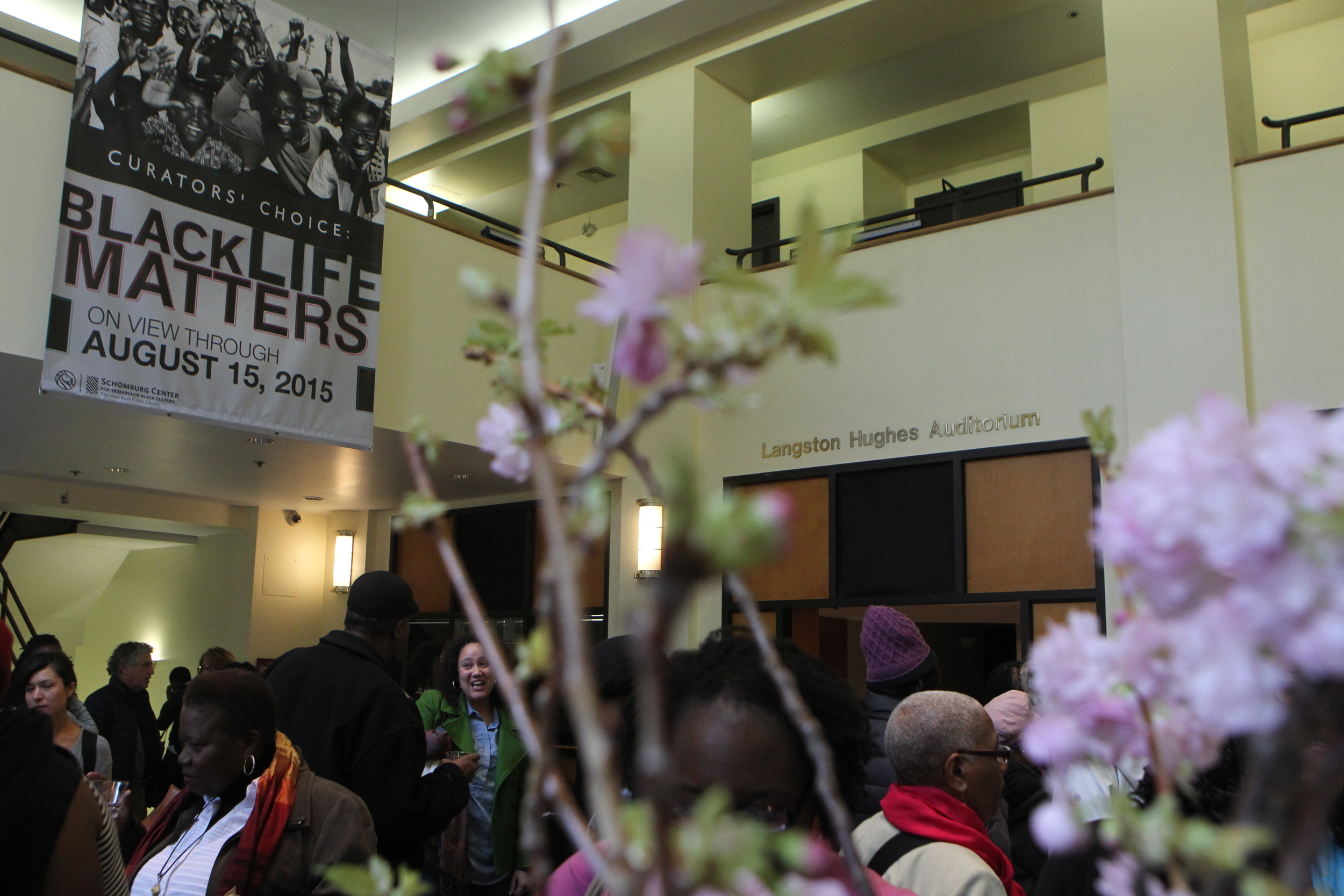
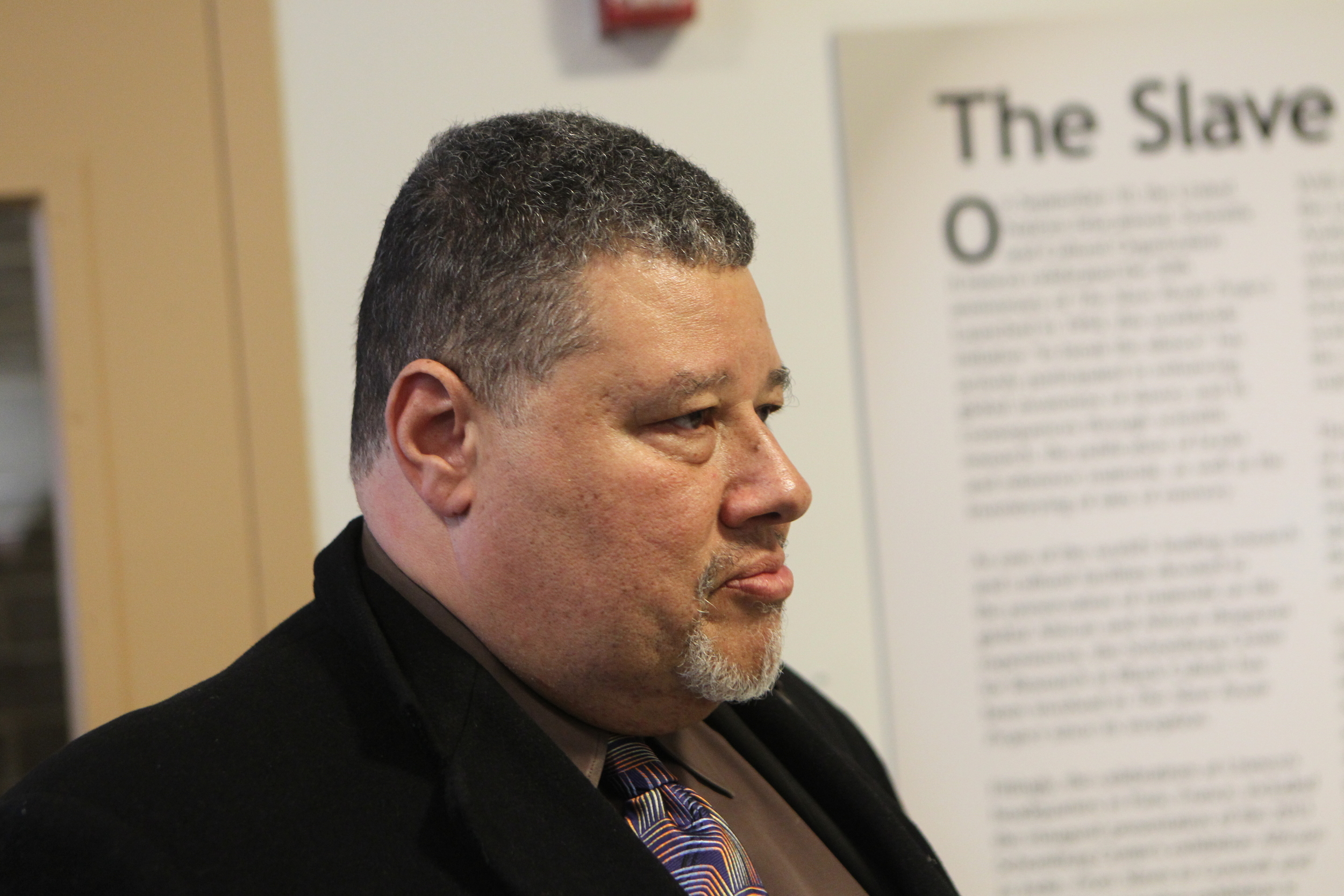
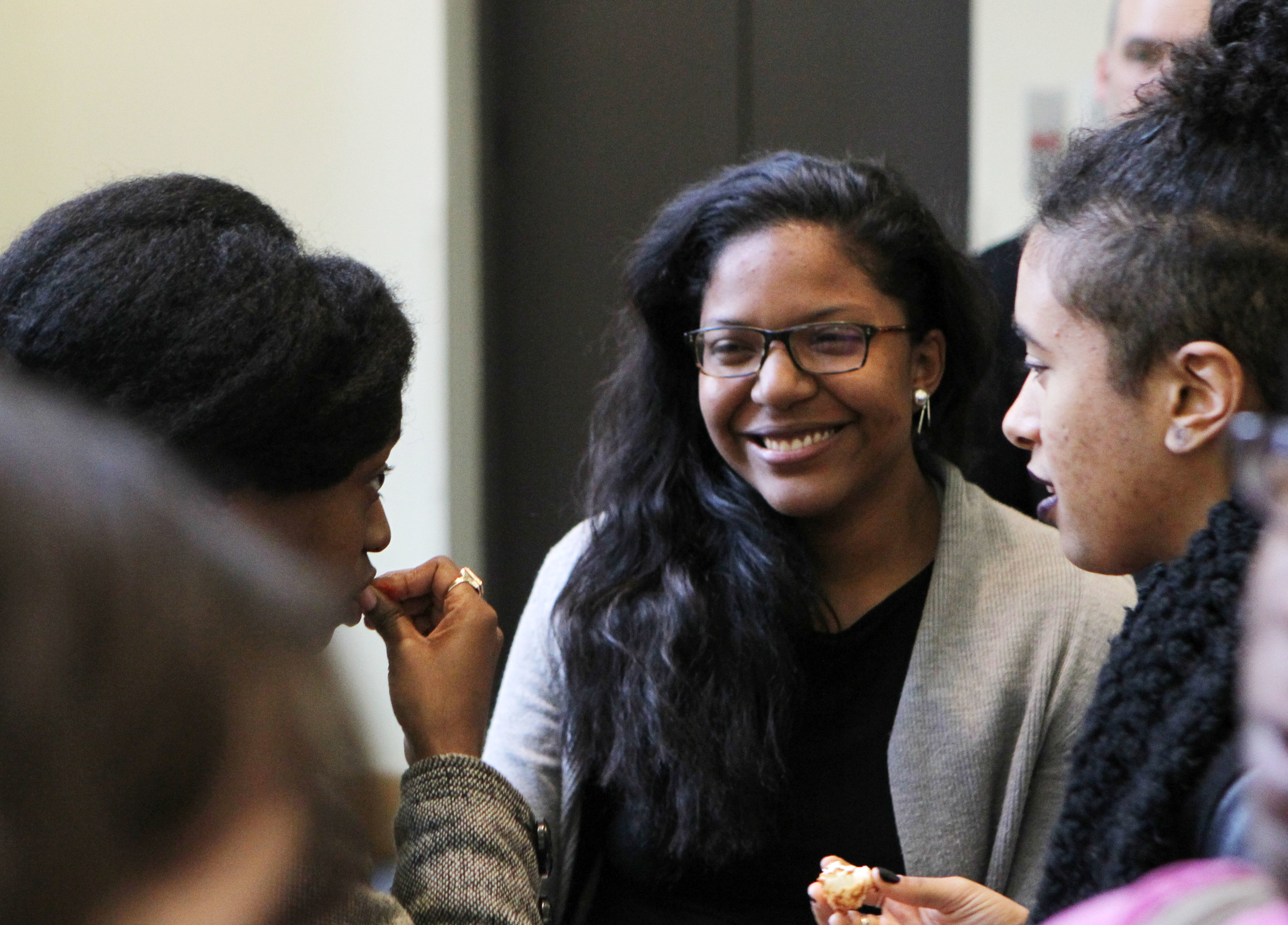
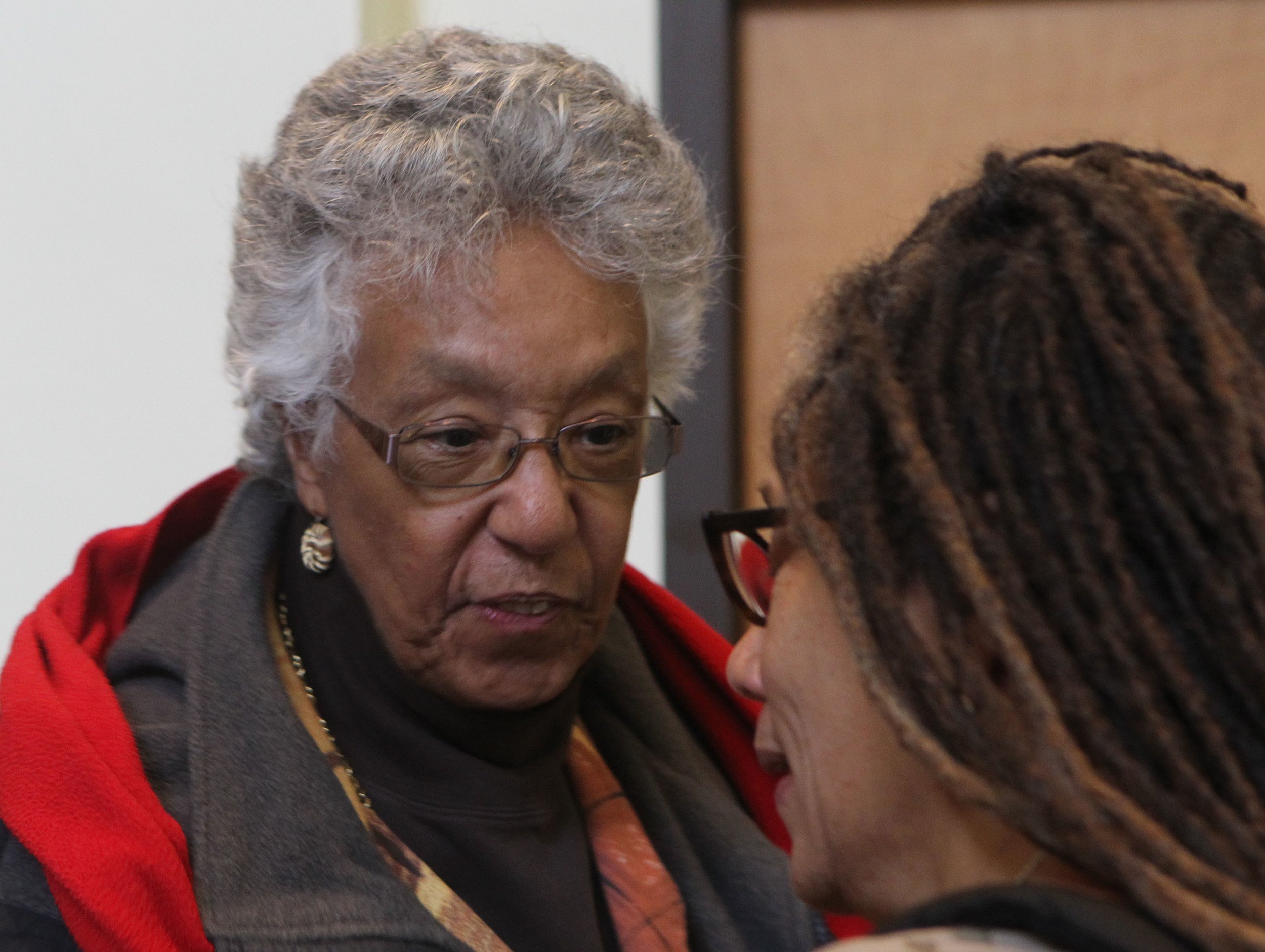
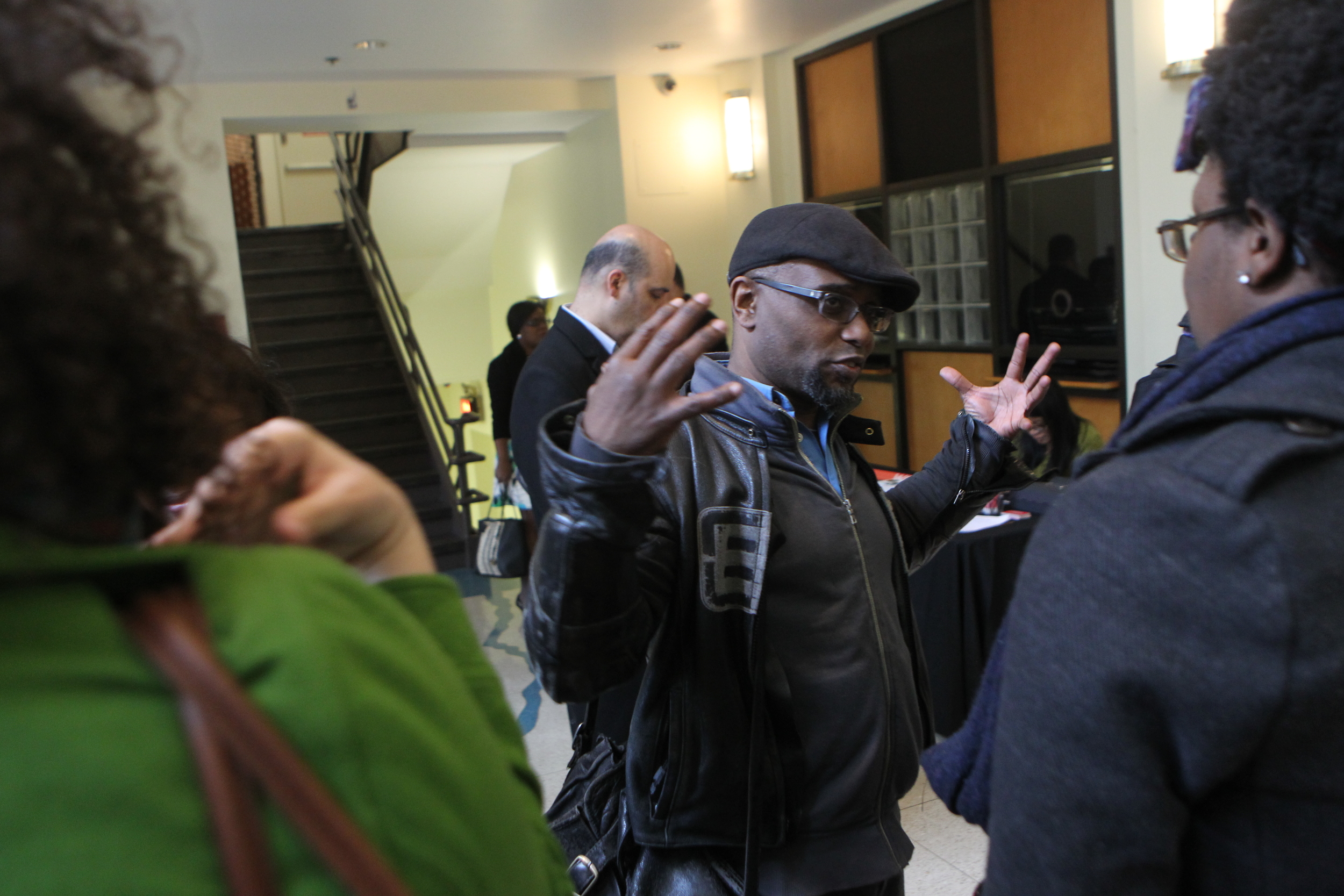
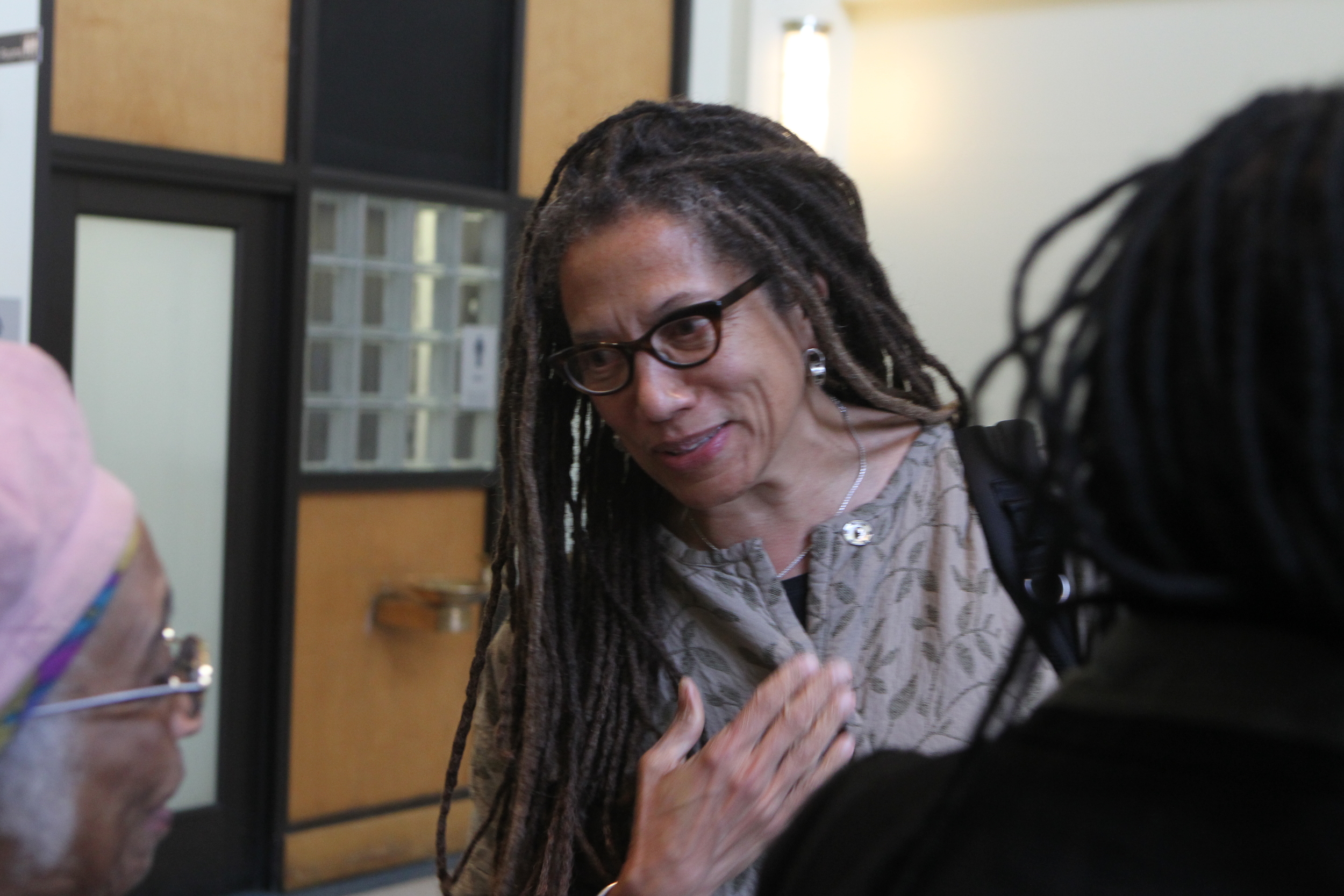
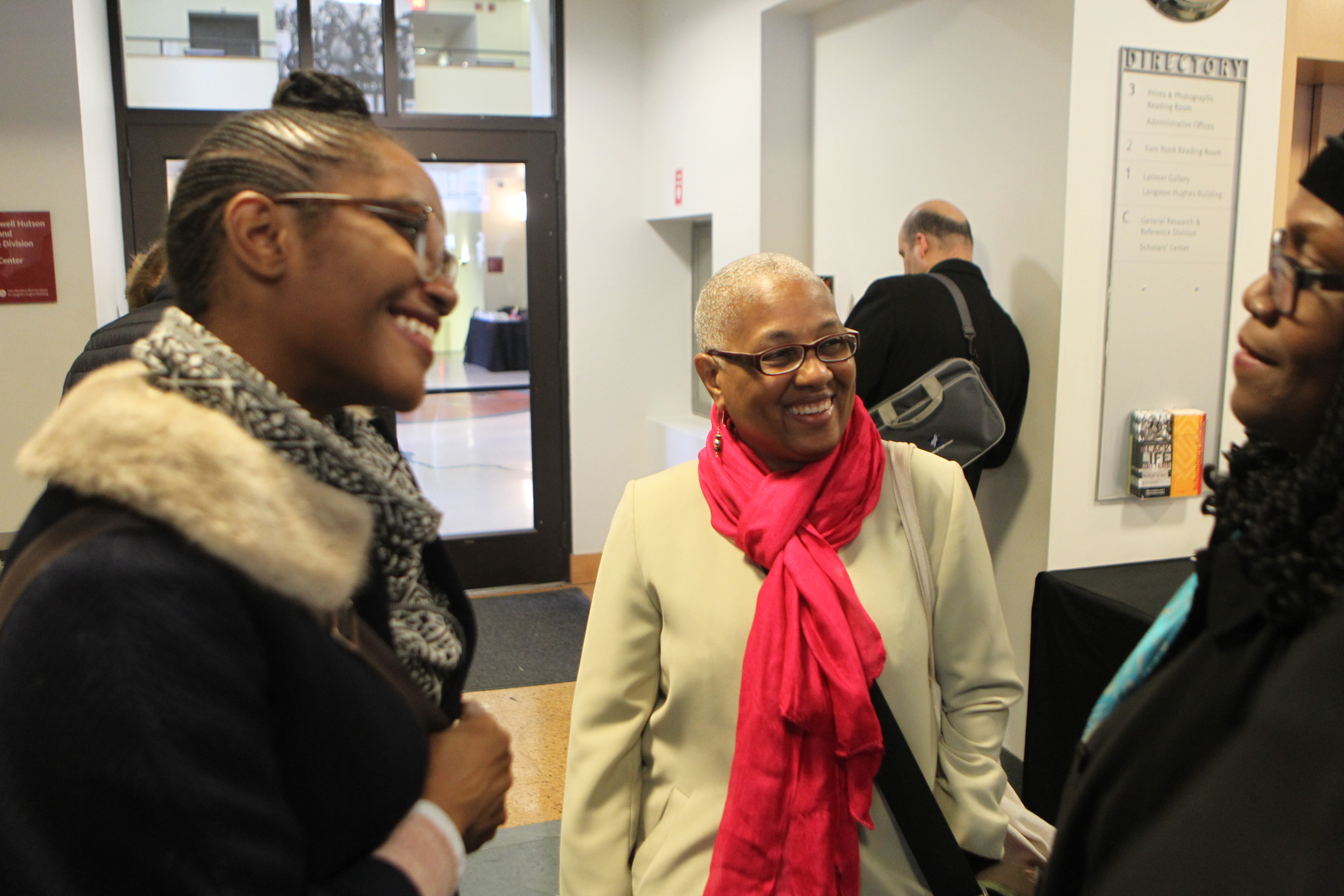
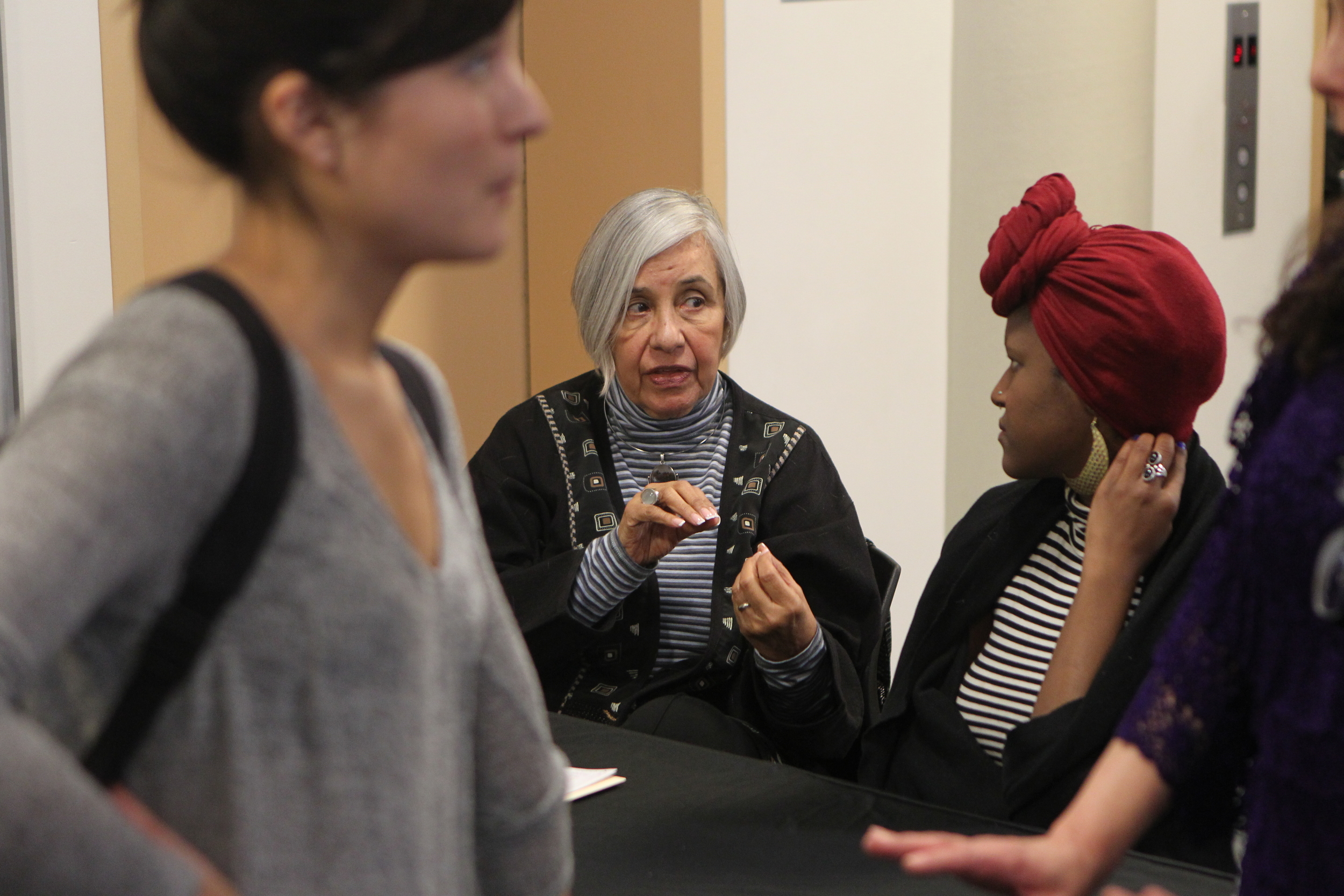
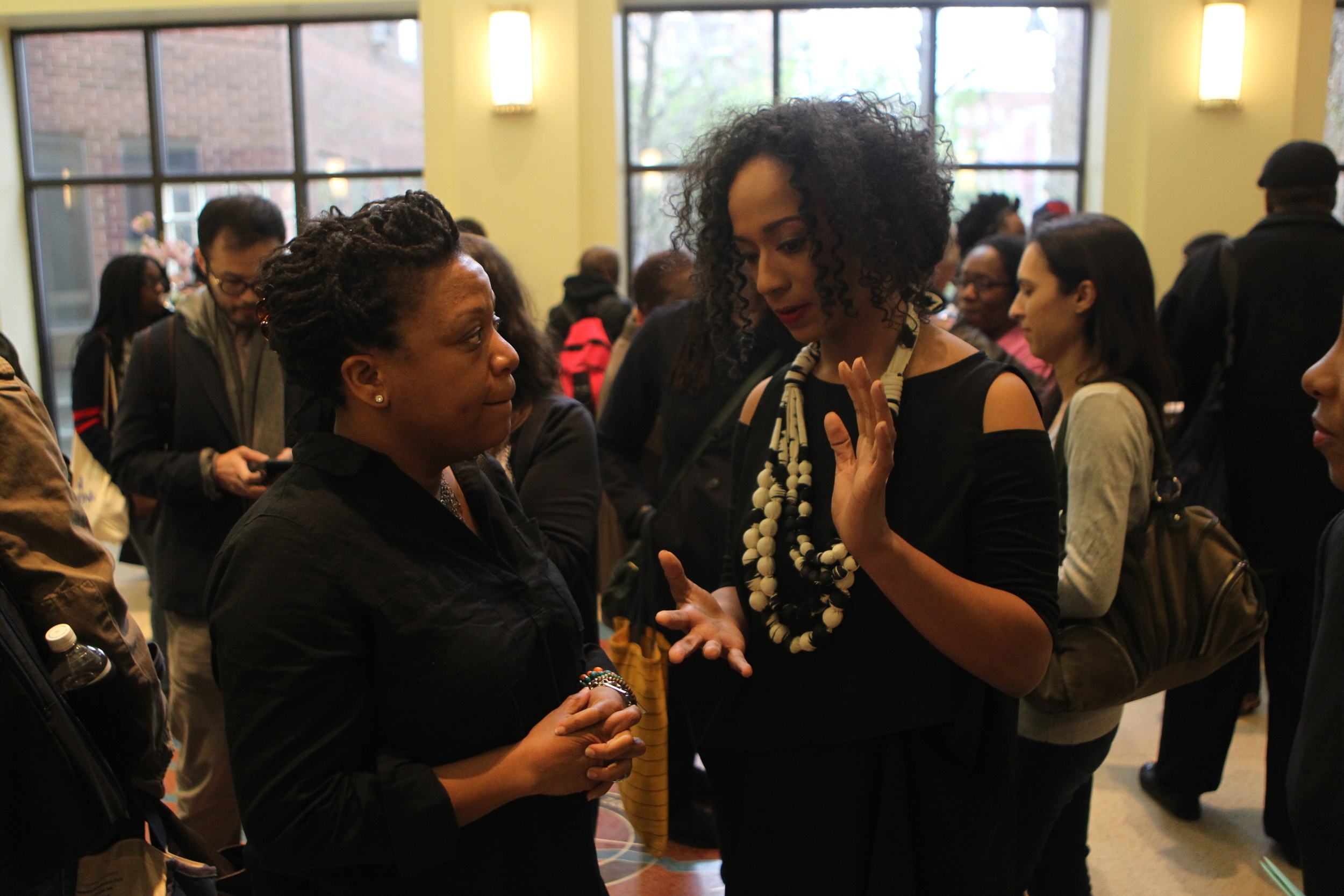
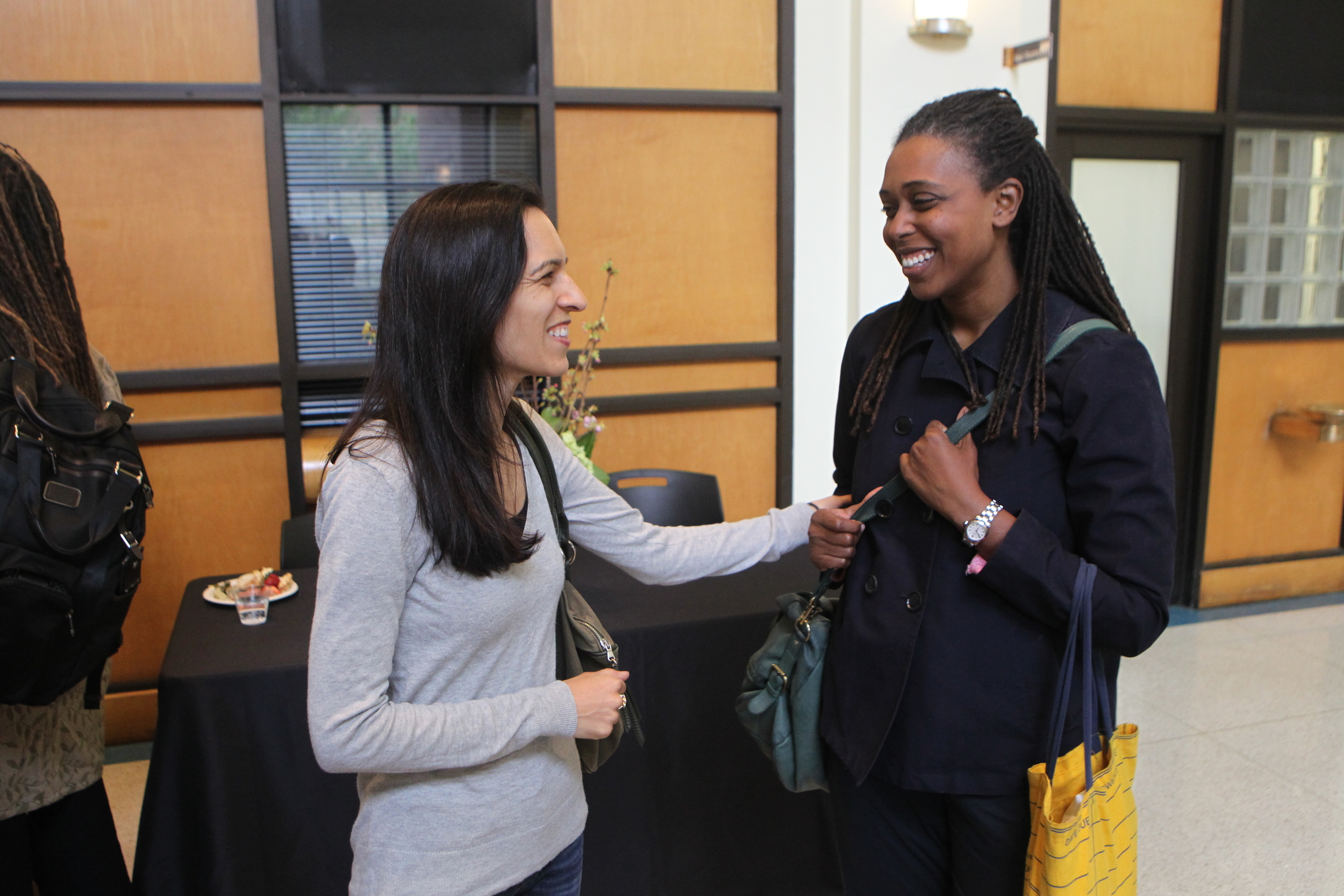
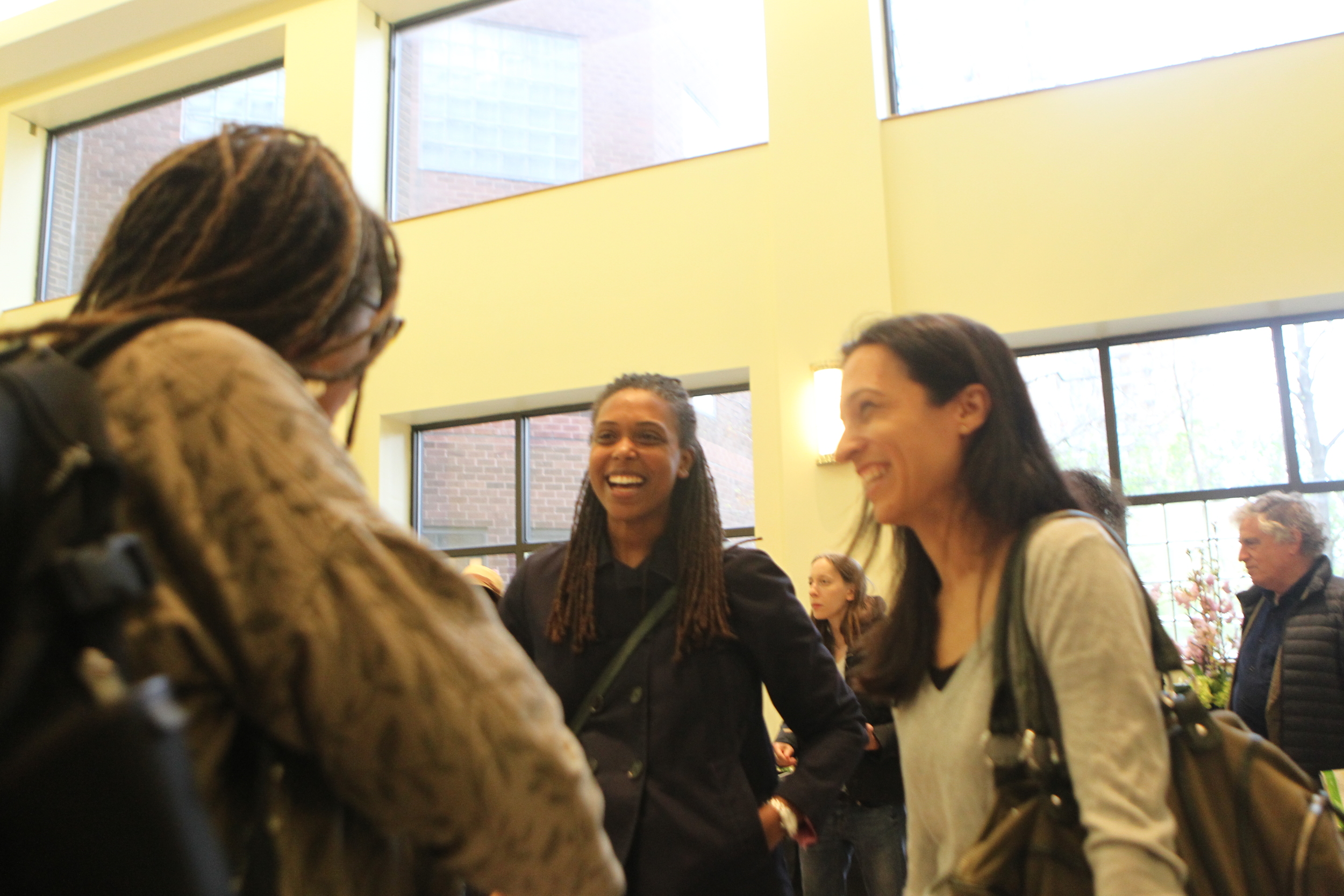
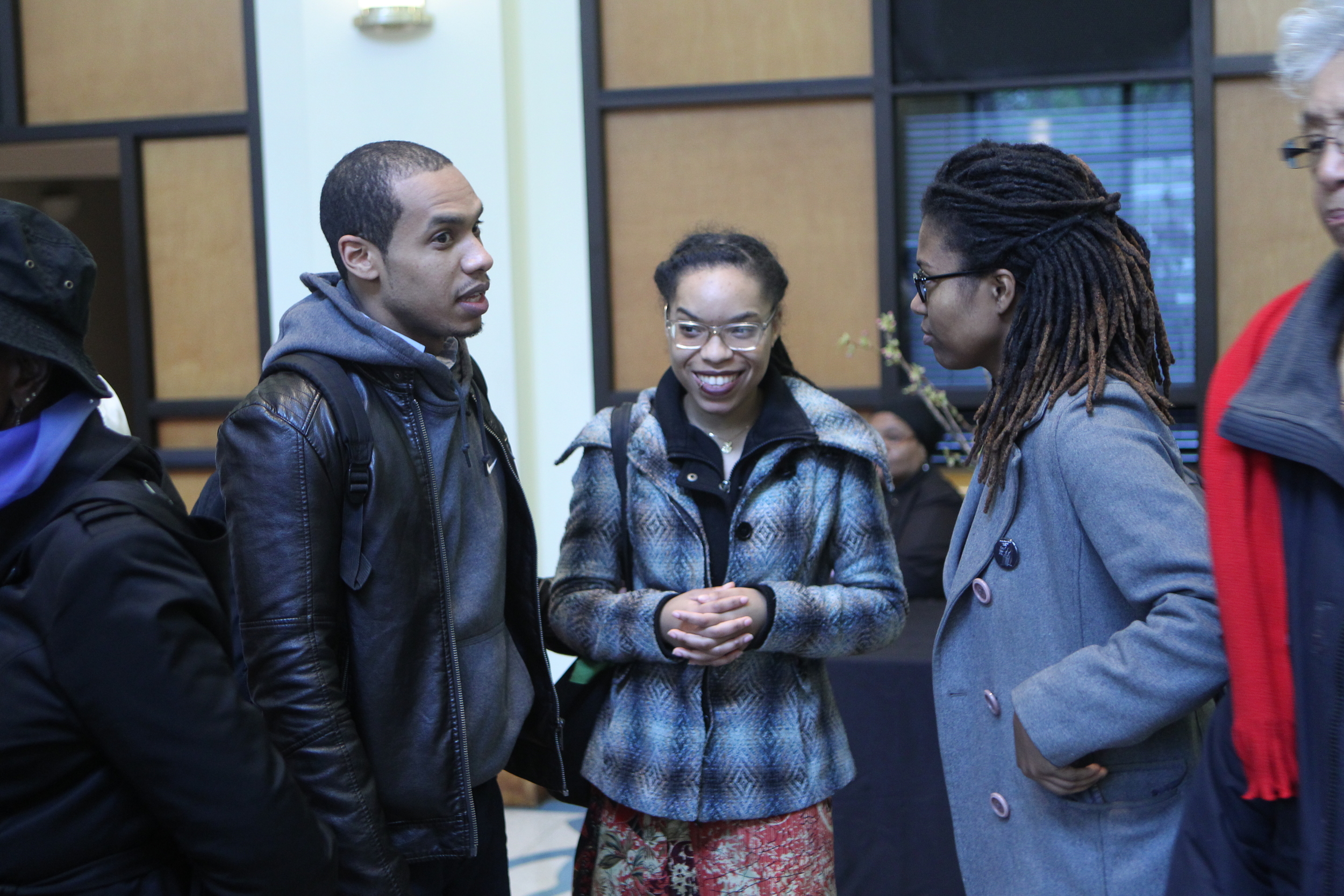
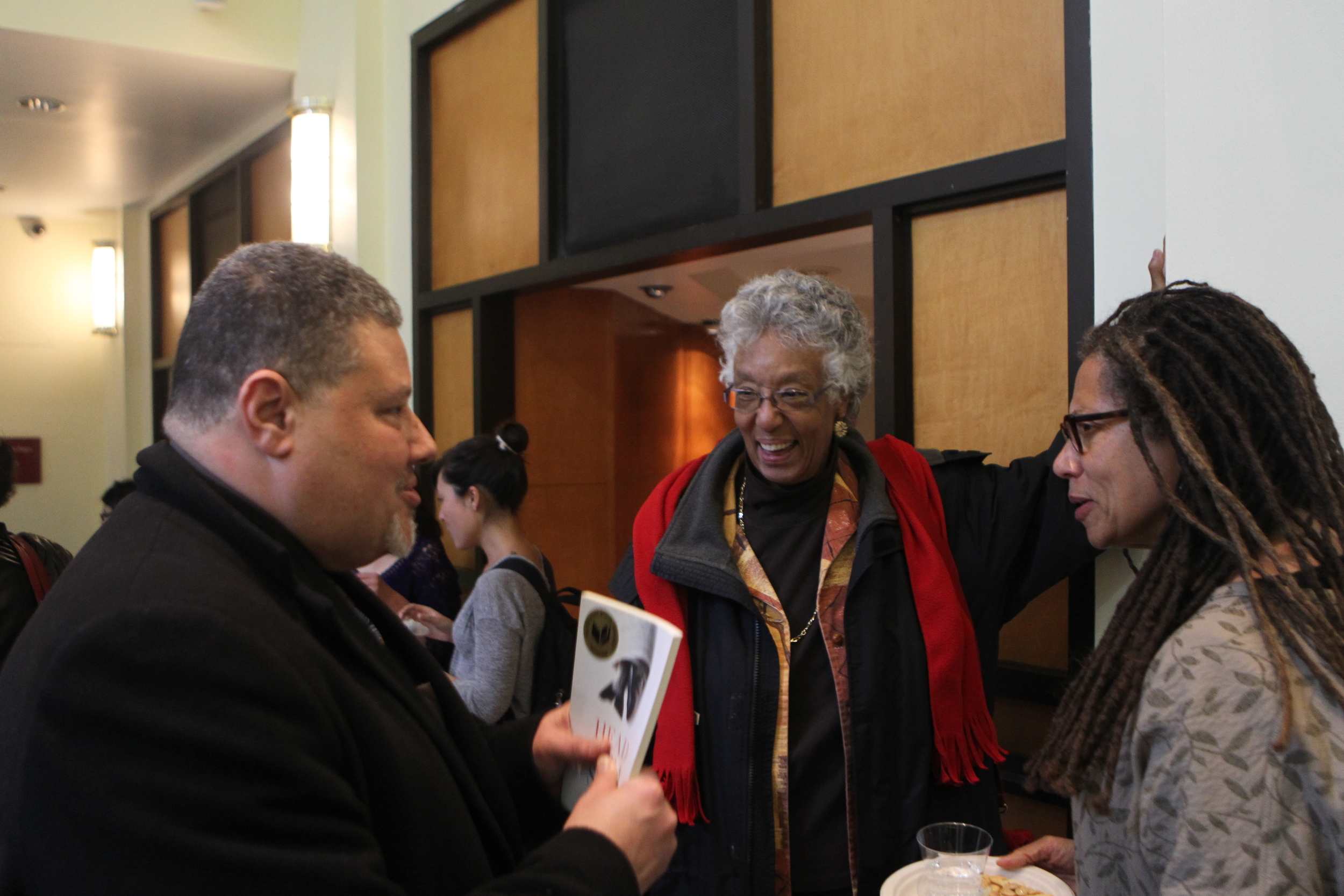
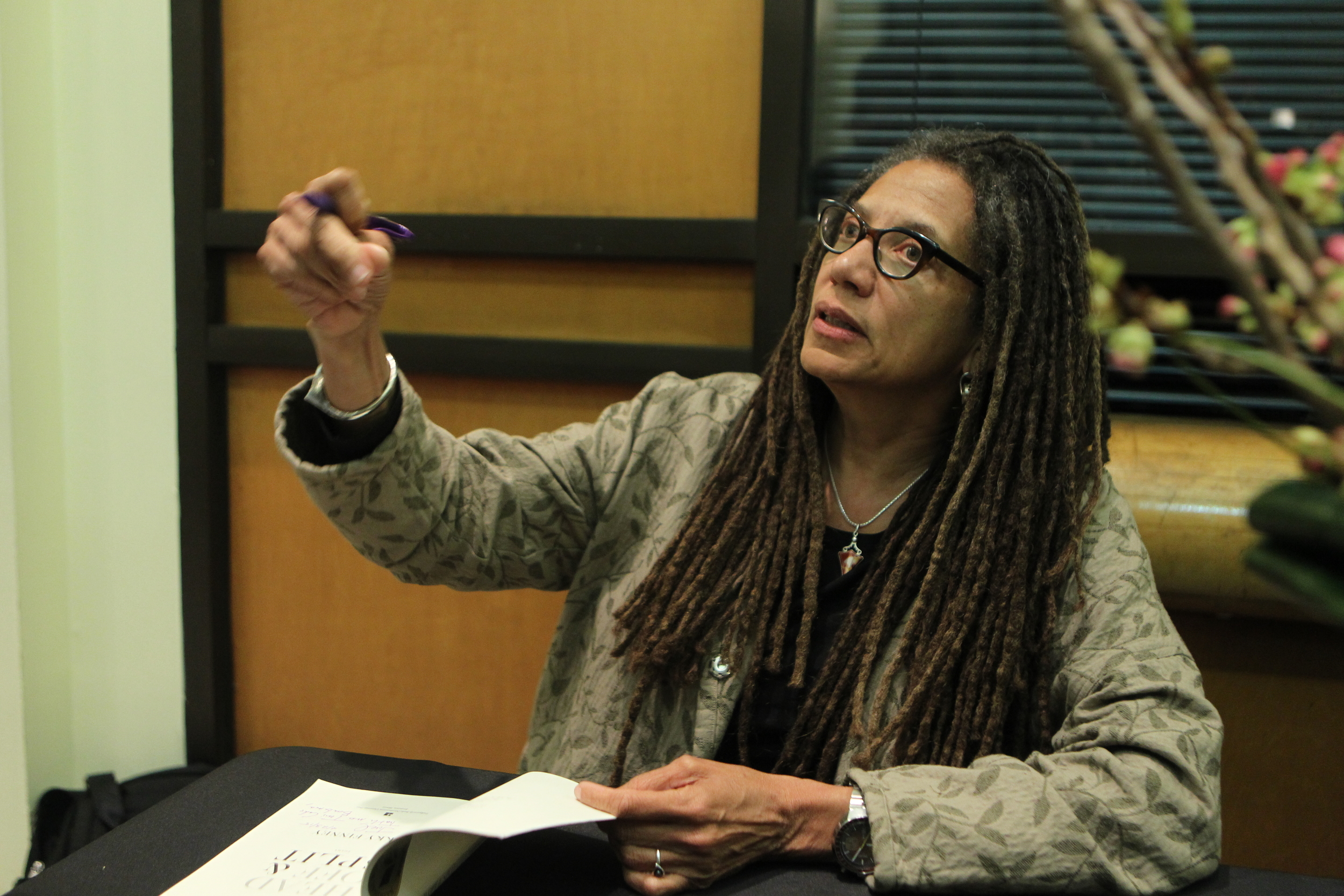
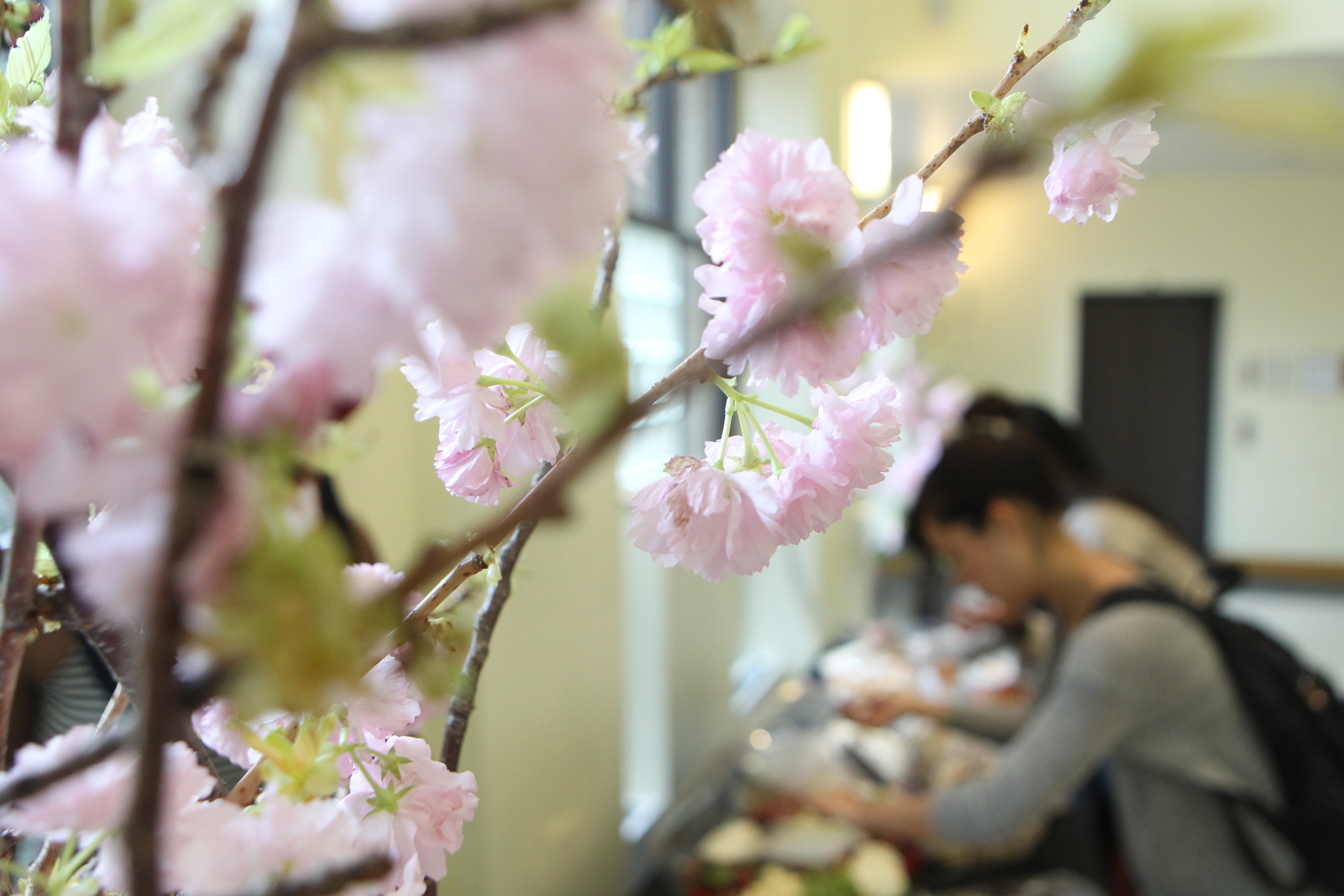
Photo Credit: Rachel Eliza Griffiths and Terrence Jennings






